-
The heavy-to-light exclusive weak decays provide a fertile ground for testing the standard model (SM) and investigating the physics beyond it. In the calculation of the amplitudes of these decays, some nonperturbative quantities, such as the decay constant, distribution amplitudes, and form factors, are essential and important inputs. For example, the dominant contribution to the amplitude of
b→sγ radiative decay is proportional to the form factors associated with the tensor current. These quantities can be evaluated by numerous different approaches, such as the Wirbel-Stech-Bauer model [1], lattice QCD [2], QCD sum rules [3, 4], and light-front quark models (LF QMs) [5–9].The LF QMs can be roughly classified into two types: the standard light-front (SLF) QM [5, 6] and the covariant light-front (CLF) QM [7–9]. The SLF QM is a relativistic quark model based on the LF formalism [10] and LF quantization of QCD [11] provides a conceptually simple and phenomenologically feasible framework for evaluating nonperturbative quantities. However, the matrix element evaluated in this approach lacks a manifestation f the Lorentz covariance, and therefore, it is subsequently replaced by the CLF QM. A popular framework for the CLF QM was developed by Jaus [9] with the help of a manifestly covariant Bethe-Saltpeter (BS) approach as a guide to the calculation. In this approach, the zero-mode contributions can be efficiently determined, and the result of the matrix element is expected to be covariant because of the
ω -dependent spurious contributions, whereωμ=(0,2,0⊥) is the light-like four-vector used to define the light-front byω⋅x=0 . Theω -dependent contributions may violate the covariance, and they can be eliminated by inclusion of zero-mode contributions [9]. The LF QMs have been widely used to evaluate some nonperturbative quantities of hadrons, and they are further applied to phenomenological researches [12–78]. In this study, we focus on the form factors related to the tensor current matrix elements.The tensor form factors of
B→π,K,ρ , andK∗ transitions have been evaluated in the SLF QM withq⊥=0 frame [79]. Within the CLF QM, the tensor form factors ofBu,d→V,A , and T transitions are calculated in Ref. [80] and are corrected in Refs. [81, 82]; the corrected theoretical results are further applied to the phenomenological studies of some radiative B andBs decays [82] and radiative D andDs decays [83]. It is worth checking these previous results of tensor form factors and evaluating the transitions that were not hereto considered. Further, it should be noted that above-mentioned studies are performed within the traditional CLF QM [9], which exhibits covariance and self-consistence problems.The traditional CLF approach [9] has long been known to suffer from a self-consistence problem in the vector meson system. For example, the CLF results for the decay constant of the vector meson,
fV , obtained via longitudinal (λ=0 ) and transverse (λ=± ) polarization states, are inconsistent with each other, i.e.,[fV]λ=0≠[fV]λ=± [60], because the former receives an additional contribution characterized by theB(2)1 function. Some analyses have been made in Ref. [84], and the authors present a possible solution to the self-consistence problem by introducing a modified correspondence between the covariant BS approach and the LF approach (named as type-II scheme [84]), which requires an additionalM→M0 replacement relative to the traditional correspondence scheme (referred to as the Type-I scheme [84]).In our previous studies [85–87], the self-consistence problem has also been studied in detail via
fP,V,A and form factors ofP→(P,V) andV→V transitions, associated with the (axial-)vector current, and the modified Type-II correspondence scheme is tested in detail as a solution to the self-consistence problem [84]. Furthermore, we have also found that the covariance of the traditional CLF QM in fact cannot be maintained strictly due to the residualω -dependent contributions; the self-consistence and covariance problems have the same origin and can be resolved simultaneously by employing the modified Type-II scheme. In this study, we extend our previous efforts on above issues to the tensor form factors ofP→P,S,V , and A transitions, and update the theoretical results within a self-consistent scheme. We also show another “new” self-consistence problem of the CLF QM, which has not been noted before.Our paper is organized as follows. In Section 2, we briefly review the SLF and the CLF QMs for the convenience of discussion, and then present our theoretical results for the tensor form factors of
P→P,S,V , and A transitions. In Section 3, the self-consistency and covariance of CLF QM are discussed in detail, and our numerical results for the tensor form factors of somec→q,s andb→q,s,c (q=u,d ) inducedP→P,S,V , and A transitions are presented. Finally, we provide a summary in Section 5. Previously obtained theoretical results are collected in Appendix A for convenience of discussion and comparison, and the values of input parameters used in the computation are collected in Appendix B. -
The hadronic matrix elements associated with tensor operators are commonly factorized in terms of tensor form factors as
⟨P″(p″)|ˉq″1σμνq′1|P′(p′)⟩=i(Pμqν−Pνqμ)FT(q2)M′+M″,

(1) ⟨S″(p″)|ˉq″1σμνγ5q′1|P′(p′)⟩=i(Pμqν−Pνqμ)UT(q2)M′+M″,

(2) for
P→P andP→S transitions, respectively, whereP=p′+p″ ,q=p′−p″ , andM′(′′) is the mass of the initial (final) state. For theP→V andP→A transitions, the tensor form factors are defined as⟨V(p″,ϵ)|ˉq″1σμν q′1|P(p′)⟩=−εμναβ{−ϵ∗αPβT1(q2)+M′2−M″2q2ϵ∗αqβ[T1(q2)−T2(q2)]−ϵ∗⋅qq2Pαqβ[T1(q2)−T2(q2)−q2M′2−M″2T3(q2)]},

(3) ⟨iA(p″,ϵ)|ˉq″1σμνγ5 q′1|P(p′)⟩=εμναβ{−ϵ∗αPβT(i)1(q2)+M′2−M″2q2ϵ∗αqβ[T(i)1(q2)−T(i)2(q2)]−ϵ∗⋅qq2Pαqβ[T(i)1(q2)−T(i)2(q2)−q2M′2−M″2T(i)3(q2)]},

(4) where
ε0123=1 ;iA withi=1 and3 denote2S+1LJ = 1P1 and3P1 states, respectively; and for the form factors in Eq. (4), the superscript “(i) ” withi=1 and3 are added to distinguish P→ 1A and P→ 3A transitions. The definitions, Eqs. (3) and (4), are equivalent to⟨V(p″,ϵ)|ˉq″1σμνqν q′1|P(p′)⟩=εμναβϵ∗νPαqβT1(q2),

(5) ⟨V(p″,ϵ)|ˉq″1σμνγ5qν q′1|P(p′)⟩=−i[(M′2−M″2)ϵμ∗−ϵ∗⋅qPμ]T2(q2)−iϵ∗⋅q[qμ−q2M′2−M″2Pμ]T3(q2),

(6) and
⟨iA(p″,ϵ)|ˉq″1σμνγ5qν q′1|P(p′)⟩=−εμναβϵ∗νPαqβT(i)1(q2),

(7) ⟨iA(p″,ϵ)|ˉq″1σμνqν q′1|P(p′)⟩=i[(M′2−M″2)ϵμ∗−ϵ∗⋅qPμ]T(i)2(q2)+iϵ∗⋅q[qμ−q2M′2−M″2Pμ]T(i)3(q2),

(8) respectively.
The main function of LF approaches is to evaluate the current matrix element of the
M′→M″ transition,B≡⟨M″(p″)|ˉq″1(k″1)Γq′1(k′1)|M′(p′)⟩,Γ=σμν,σμνγ5,...

(9) which will be further used to extract the form factors by matching to the definitions given above.
-
The SLF and CLF QMs were fully illustrated in e.g., Refs. [5, 6, 12, 13, 29] and Refs. [9, 59, 60, 84], respectively. One may refer to these literatures for detail. In this study, we assume the same notations and conventions as Refs. [85–87].
In the framework of the SLF QM, the matrix element, Eq. (9), can be written as [85–87]
BSLF=∑h′1,h″1,h2∫dxd2k′⊥(2π)32xψ″∗(x,k″⊥)ψ′(x,k′⊥)S″†h″1,h2(x,k″⊥)×Ch″1,h′1(x,k′⊥,k″⊥)S′h′1,h2(x,k′⊥),

(10) where
Ch″1,h′1(x,k′⊥,k″⊥)≡ˉuh″1(x,k″⊥)Γuh′1(x,k′⊥) corresponds to the operator in Eq. (9); x andk′⊥ are the internal LF relative momentum variables. The momenta of quarkq′1 and spectator anti-quarkˉq2 in the initial state have been written in terms of(x,k′⊥) ask′+1=xp′+,k′1⊥=xp′⊥+k′⊥;k+2=ˉxp′+,k2⊥=ˉxp′⊥−k′⊥,

(11) where
ˉx=1−x . For the convenience of calculation, it is usually assumed that the initial state moves along the z-direction, which implies thatp′⊥=0 . Taking the convenient Drell-Yan-West frame,q+=0 , whereq≡p′−p″=k′1−k″1 is the momentum transfer, the momentum of quarkq″1 in the final state can be written ask″+1=xp″+=xp′+,k″1⊥=xp″⊥+k″⊥=−xq⊥+k″⊥,

(12) where
k″⊥=k′⊥−ˉxq⊥ .In Eq. (10),
ψ(x,k⊥) andSh1,h2(x,k⊥) are the radial and the spin-orbital wavefunctions (WFs). For the former, we adopt commonly used Gaussian-type WFs, which are written asψs(x,k⊥)=4π34β32√∂kz∂xexp[−k2z+k2⊥2β2],

(13) ψp(x,k⊥)=√2βψs(x,k⊥),

(14) for s-wave and p-wave mesons, respectively. The Gaussian parameters
β can be determined by fits to data;kz is the relative momentum in the z-direction and can be written askz=(x−12)M0+m22−m212M0,

(15) with the invariant mass defined by
M20=m21+k2⊥x+m22+k2⊥ˉx.

(16) For the latter,
Sh1,h2(x,k⊥) can be obtained by the interaction-independent Melosh transformation, and finally written as a covariant form [13, 60],Sh1,h2=ˉu(k1,h1)ΓMv(k2,h2)√2ˆM0,

(17) where
ˆM20=M20−(m1−m2)2 . For the P, S, V, and A states,ΓM has the formΓP=γ5,

(18) ΓV=−⧸ˆϵ+ˆϵ⋅(k1−k2)DV,LF,

(19) ΓS=ˆM202√3M0,

(20) Γ1A=−1D1,LFˆϵ⋅(k1−k2)γ5,

(21) Γ3A=−ˆM202√2M0[⧸ˆϵ+ˆϵ⋅(k1−k2)D3,LF]γ5,

(22) where
DV,LF=M0+m1+m2 ,D1,LF=2 ,D3,LF=ˆM20/(m1−m2) andˆϵμλ=0=1M0(p+,−M20+p2⊥p+,p⊥),

(23) ˆϵμλ=±=(0,2p+ϵ⊥⋅p⊥,ϵ⊥),ϵ⊥≡∓(1,±i)√2.

(24) Using the formulas given above, the explicit expression of
BSLF can be obtained, which is further used to extract the form factors. The form factor in the SLF QM can be written as[F(q2)]SLF=∫dxd2k′⊥(2π)32xψ″∗(x,k″⊥)ψ′(x,k′⊥)2ˆM′0ˆM″0˜FSLF(x,k′⊥,q2).

(25) For the
P→P andP→S transitions, takingμ=+ andν=⊥ , we finally obtain˜FSLFT=−2(M′+M″)(m′1k″⊥⋅q⊥−m″1k′⊥⋅q⊥−xm2q2⊥)q2⊥,

(26) ˜USLFT=ˆM″202√3M″0˜FSLFT[m″1→−m″1],

(27) where “
˜FSLFT[m1→−m″1] ” indicates the replacement ofm″1 in˜FSLFT by−m″1 . For theP→V andP→A transitions, we takeλ=+ and multiply both sides of Eqs. (3) and (4) by(ϵμqν,ϵμPν,ϵμϵ∗ν) for convenience of extracting the form factorsT(1,2,3) . The final results are written as˜TSLF1=1(M′2−M″2+q2⊥)1xˉx{2x(xm2+ˉxm′1)(xm2+ˉxm″1)(M′2−M″2)+2x2(M′2−M″2)k′⊥⋅k″⊥+(xm2+ˉxm′1)[xm2+ˉx(x−ˉx)m′1+2xˉxm″1]q2⊥−[2x2m22+ˉx(x−ˉx)m′21−ˉxm″21]k′⊥⋅q⊥+2(ˉx−x)k″⊥⋅q⊥k′⊥⋅k″⊥+(1−2xˉx)k′⊥⋅k″⊥q2⊥+2D″V[xˉx(M′2−M″2)[(m′1+m″1)k′⊥⋅k″⊥−(xm2+ˉxm′1)k″⊥⋅q⊥]−(m′1+m″1)(ˉxm′1+xm2)(ˉxm″1−xm2)k″⊥⋅q⊥+ˉx(xm2+ˉxm′1)(k″⊥⋅q⊥)2−xˉx(m′1+m″1)(k′⊥⋅q⊥)2+xˉx(m′1+m″1)k′2⊥q2⊥+(x−ˉx)(m′1+m″1)k″⊥⋅q⊥k′⊥⋅k″⊥−ˉx(ˉxm″1−xm2)k′⊥⋅q⊥k″⊥⋅q⊥]},˜TSLF2=˜TSLF1+q2(M′2−M″2)(M′2−M″2+q2⊥)1x2ˉx{4ˉx(k′⊥⋅k″⊥)2−x(1−2xˉx)k′⊥⋅k″⊥q2⊥+4ˉxk′⊥⋅q⊥k″2⊥+2(x−2ˉx)k′⊥⋅k″⊥k″⊥⋅q⊥−x2(ˉxm′1+xm2)(m2−2ˉxm″1)q2⊥+4ˉxm″1(xm2+m″1)k′2⊥+(x2+3xˉx−4ˉx)m′1(ˉxm′1+xm2)k″⊥⋅q⊥+[3xˉxm″21−x2m′1(4ˉxm″1−ˉxm2+xm2)+8ˉxx2m″1m2+2x3m22]k′⊥⋅q⊥−2x3(M′2+M″2)k′⊥⋅k″⊥+4m′1(ˉx2m′1+x2m″1+xˉxm2)k′⊥⋅k″⊥−2(ˉxm′1+xm2)(ˉxm″1+xm2)[x2(M′2+M″2)−2m′1m″1]+2xD″V[4m′1(k′⊥⋅k″⊥)2+ˉxk′⊥⋅k″⊥q2⊥(xm″1+2m2−m′1+3ˉxm′1)−2k′⊥⋅k″⊥k′2⊥(m′1−m″1)−2xˉxm2k′⊥⋅q⊥k″⊥⋅q⊥−ˉx2k″⊥⋅q⊥q2⊥(ˉxm′1+xm2)+k′2⊥k″⊥⋅q⊥(m′1−m″1−2ˉxm2)+2k′⊥⋅k″⊥k″⊥⋅q⊥(xm″1−m′1+2ˉxm2)−xˉxk′⊥⋅k″⊥(m′1+m″1)(M′2+M″2)+xˉxk″⊥⋅q⊥(ˉxm′1+xm2)(M′2+M″2)+2k′⊥⋅k″⊥(m′1+m″1)[ˉx(m′1−m2)(m″1+m2)+m22]+k″⊥⋅q⊥(ˉxm′1+xm2)[(m′1+m″1)(xm2−ˉxm″1)−2m′1m2]]},

(28) ˜TSLF3=M′2−M″2q2[˜TSLF1−˜TSLF2]+2(M′2−M″2)xˉx(M′2−M″2+q2⊥)q2⊥{ˉxm″21k′⊥⋅q⊥−x2m22q2⊥+k″⊥⋅q⊥[(1−2x)ˉxm′21−2x2m22]+(1−2x)k′⊥⋅k″⊥(2k″⊥⋅q⊥+q2⊥)+2D″Vk″⊥⋅q⊥[(2x−1)(m′1+m″1)k′⊥⋅k″⊥+(ˉx−x)(ˉxm′1+xm2)k″⊥⋅q⊥−k′⊥⋅q⊥(ˉxm″1−xm2)+(ˉxm′1+xm2)(xm2−ˉxm″1)(m′1+m″1)]};

(29) ˜T(1),SLF1,2,3=˜TSLF1,2,3[D″−termsonly,D″V→D″1,m″1→−m″1];

(30) ˜T(3),SLF1,2,3=ˆM″202√2M″0˜TSLF1,2,3[D″V→D″3,m″1→−m″1].

(31) Notably, only the
D″ -terms are kept in˜T(1),SLF1,2,3 , and the replacementm″1→−m″1 must not be applied to them″1 inD″ factor. -
To maintain manifest covariance and explore the zero-mode effects, a CLF approach is presented in Refs. [9, 59, 60] with the help of a manifestly covariant BS approach as a guide to the calculation. In the CLF QM, the matrix element for
M′→M″ transition is obtained by calculating the Feynman diagram shown in Fig. 1, and can be written as a manifest covariant form,BCLF=Nc∫d4k′1(2π)4HM′HM″N′1N″1N2iS⋅(EM′E∗M″),

(32) where
d4k′1=12dk′−1dk′+1d2k′⊥ ,EP,S=1 , andEV,A=ϵμ , the denominatorsN(′,′′)1=k(′,′′)21−m(′,′′)21+iϵ andN2=k22− m22+iϵ come from the fermion propagators, andHM′,M″ are vertex functions. The trace term S related to the fermion loop is written asS=Tr[Γ(⧸k′1+m′1)(iΓM′)(−⧸k2+m2)(iγ0Γ†M″γ0)(⧸k″1+m″1)],

(33) where
ΓM(′,′′) is the vertex operator and can be written as [9, 60, 84]iΓP=−iγ5,

(34) iΓS=−i,

(35) iΓV=i[γμ−(k1−k2)μDV,con],

(36) iΓ1A=i(k1−k2)μD1,conγ5,

(37) iΓ3A=i[γμ+(k1−k2)μD3,con]γ5,

(38) with the constant forms of D factors,
D(V,1,3),con= (M+m1+m2,2,M2/(m1−m2)) .Integrating out the minus component of loop momentum, the covariant calculation becomes the LF calculation. By closing the contour in the upper complex
k′−1 plane and assuming thatHM′,M″ are analytic within the contour, the integration picks up a residue atk22=ˆk22=m22 corresponding to placement of the spectator antiquark on its mass-shell. Consequently, integrating out the minus component, one has the following replacements [9, 60]N1→ˆN1=x(M2−M20)

(39) and
χM≡HM/N→hM/ˆN,Dcon→DLF,(type−I)

(40) where the LF forms of vertex functions,
hM , for P, S, V, and A mesons are given byhP/ˆN=hV/ˆN=1√2Nc√ˉxxψsˆM0,

(41) hS/ˆN=1√2Nc√ˉxxˆM′202√3M′0ψpˆM0,

(42) h1A/ˆN=1√2Nc√ˉxxψpˆM0,

(43) h3A/ˆN=1√2Nc√ˉxxˆM′202√2M′0ψpˆM0.

(44) As has aforementioned, a manifestly covariant BS approach is employed as a guide for the CLF calculation. Eq. (40) shows the Type-I correspondence between the manifestly covariant and LF models. In this formula, the correspondence between
χ andψ can be clearly derived by matching the covariant expressions to the SLF ones via zero-mode independentfP orfP→P+(q2) [9, 60]; however the validity of the correspondence for the D factor appearing in the vertex operator,DV,con→DV,LF , has not yet been explicitly clarified [84], it limits the replacementM→M0 only in the D factors. It should be noted that the covariant and the SLF results forfP andfP→P+ are very simple (no meson mass appears in their formulas), thus the Type-I correspondence is possibly incomplete, as some other possible correspondences are impossible to obtain directly by matching the covariant result forfP orfP→P+ to the SLF one. The main difference between the results in the manifestly covariant and SLF models is that the former allows nonzero binding energy, whereas the later is obtained at the zero-binding-energy limit at one-loop approximation (i.e., M vs.M0 ). Based on these facts, instead of the traditional Type-I correspondence, a significantly more generalized correspondence,①χM≡HM/N→hM/ˆN,M→M0,(type−II)

(45) is suggested by Choi et al. for the purpose of self-consistent results for
fV [84] (one may refer to Refs. [84–87] for more discussions).After integrating out
k′−1 , the matrix element, Eq. (32), can be reduced to the LF formˆBCLF=Nc∫dxd2k′⊥2(2π)3hM′hM″ˉxˆN′1ˆN″1ˆS⋅(EM′E∗M″).

(46) Notably, the matrix element in the CLF approach,
BCLF given by Eq. (32), receives spurious contributions proportional to the light-like vectorωμ=(0,2,0⊥) , and these undesired spurious contributions are expected to be cancelled out by the zero-mode contributions [9, 60]. The inclusion of the zero-mode contribution in practice amounts to some proper replacements forˆk′1 andˆN2 inˆS under integration [9]. In this study, we requireˆk′μ1→PμA(1)1+qμA(1)2,

(47) ˆk′μ1ˆk′ν1→gμνA(2)1+PμPνA(2)2+(Pμqν+qμPν)A(2)3+qμqνA(2)4+Pμων+ωμPνω⋅PB(2)1,

(48) ˆk′μ1ˆN2→qμ(A(1)2Z2+q⋅Pq2A(2)1),

(49) where A and
B functions are written asA(1)1=x2,A(1)2=x2−k′⊥⋅q⊥q2;

(50) A(2)1=−k′2⊥−(k′⊥⋅q⊥)2q2,A(2)2=(A(1)1)2,A(2)3=A(1)1A(1)2,A(2)4=(A(1)2)2−1q2A(2)1,B(2)1=x2Z2−A(2)1;

(51) Z2=ˆN′1+m′21−m22+(ˉx−x)M′2+(q2+q⋅P)k′⊥⋅q⊥q2.

(52) Here, we clarify that three types of terms appear in the decomposition of
ˆk′μ1 ,ˆk′μ1ˆk′ν1 , etc., and are usually characterized by A, B, and C functions, respectively. The terms associated with A functions areω -independent, which can be clearly seen from Eqs. (47)–(49); the mainω -dependent terms are associated with C functions, while these contributions are exactly eliminated by the inclusion of zero-mode contributions [9], and thus are not shown in Eqs. (47) and (48) for simplicity (one may refer to Ref. [9] for further detail); however, there are still some residualω -dependent, zero-mode independent, terms, which are associated with the B functions [9] (for instance, the last term in Eq. (48)). These residualω -dependent contributions possibly result in the covariance and self-consistence problems; however, they are not fully considered in some of the previous studies based on the CLF QM.In the CLF QM, the tensor form factors are obtained directly by matching
ˆBCLF to their definitions given by Eqs. (1), (2), and (5)–(8)②. Our final CLF results for the tensor form factors can be written as[F(q2)]CLF=Nc∫dxd2k′⊥2(2π)3χM′χM″ˉx˜FCLF(x,k′⊥,q2),

(53) where the integrands are
˜FCLFT=2(M′+M″)[m′1−(m′1+m″1−2m2)A(1)1−(m′1−m″1)A(1)2];

(54) ˜UCLFT=˜FCLFT[m″1→−m″1];

(55) ˜TCLF1=(2ˉx−1)(m′21+ˆN′1)+m″21+ˆN″1+q2⊥+2(ˉxm′1m″1+xm′1m2+xm″1m2)−8A(2)1+2(M′2−M″2)(A(1)1+2A(2)2−2A(2)3)+2q2⊥(A(1)1−2A(1)2−2A(2)3+2A(2)4)−4D″V,con(m′1+m″1)A(2)1,

(56) \begin{split}\quad\quad \widetilde{T}_2^{\rm {CLF}} = &-(m'_1-m''_1)^2-\hat N'_1-\hat N''_1+\bar xq^2+x\left[M'^2+M''^2+2(m'_1-m_2)(m_2-m''_1)\right]-\frac{q^2}{M'^2-M''^2}\bigg\{ 2M'^2+(m''_1-m'_1)^2\\ &-2(m'_1-m_2)^2-\hat N'_1+\hat N''_1-q^2-2Z_2+4Z_2A^{(1)}_2-4A^{(2)}_1-2\left[M'^2+M''^2-q^2+2(m'_1-m_2)(m_2-m''_1)\right]A^{(1)}_2\bigg\}\\ &-\frac{4}{D''_{V,{\rm {con}}}}A^{(2)}_1\left[m'_1+m''_1+\frac{{ \bf q}_\bot^2}{M'^2-M''^2}(m'_1-m''_1-2m_2)\right]\,, \end{split}

(57) \begin{split}\quad\quad \widetilde{T}_3^{\rm {CLF}} = &2M'^2-2(m'_1-m_2)^2+(m'_1-m''_1)^2-\hat N'_1+\hat N''_1-q^2-2Z_2-4A^{(2)}_1+4\left(M'^2-M''^2\right)\left(A^{(1)}_1-A^{(2)}_2+A^{(2)}_4\right)\\ &+\dfrac{4\left(M'^2-M''^2\right)}{q^2}A^{(2)}_1+2\left[M''^2-3M'^2+q^2+2Z_2+2(m'_1-m_2)(m''_1-m_2)\right]A^{(1)}_2\\ &+\dfrac{4}{D''_{V,{\rm {con}}}}\times\bigg\{\left(M'^2-M''^2\right)\Big[m'_1\left(2A^{(1)}_1+2A^{(1)}_2-A^{(2)}_2-2A^{(2)}_3-A^{(2)}_4-1\right)\\ &-m''_1\left(A^{(1)}_1-A^{(1)}_2-A^{(2)}_2+A^{(2)}_4\right)-2m_2\left(A^{(1)}_1-A^{(2)}_2-A^{(2)}_3\right)\Big]+(m''_1-m'_1+2m_2)A^{(2)}_1\bigg\}\,; \end{split}

(58) \widetilde{T}_{1,2,3}^{(1)\,,\rm{CLF}} = \widetilde{T}_{1,2,3}^{\rm {CLF}}\left[{D''-{\rm{terms}}\; {\rm{only}}}\,, D''_{V,{\rm {con}}}\to D''_{1,{\rm {con}}}\,,m''_1\rightarrow-m''_1\right]\,;

(59) \widetilde{T}_{1,2,3}^{(3)\,,\rm{CLF}} = \widetilde{T}_{1,2,3}^{\rm {CLF}}[D''_{V,{\rm {con}}}\to D''_{3,{\rm {con}}}\,,m''_1\rightarrow-m''_1]\,.

(60) Similar to the case of SLF results, only the
D'' -terms are kept in\widetilde{\cal T}_{1,2,3}^{(1)\,,\rm{ CLF}} , and the replacementm''_1\to-m''_1 must not be applied to them''_1 inD'' factors. The CLF results Eqs. (53)–(60) are given in a general form, and the results within Type-I and -II correspondence schemes can be easily obtained by applying Eq. (40) and Eq. (45), respectively. Notably, the\omega -dependent contributions associated with B functions are not included in the results given above. These contributions lead to the self-consistence and covariance problems, and they are given and analyzed separately in the following section. Comparing our results for theP\to V\; (A) transition, Eqs. (56)–(58), with the ones obtained in the previous studies [81, 82], Eqs. (91)–(93), which are summarized in Appendix A, we find that our result for\widetilde{T}_1^{\rm {CLF}} , Eq. (56), is exactly the same as the one in Refs. [81, 82], Eq. (91); however, the results for\widetilde{T}_{2,3}^{\rm {CLF}} are different. This inconsistency will be analyzed in detail in the following section.In the CLF QM, for a given quantity (
\cal Q ), the CLF result ({\cal Q}^{\rm {CLF}} ) can be expressed as a sum of valence ({\cal Q}^{\rm {val.}} ) and zero-mode ({\cal Q}^{\rm {z.m.}} ) contributions [84],{\cal Q}^{\rm {CLF}} = {\cal Q}^{\rm {val.}}+ {\cal Q}^{\rm {z.m.}} , where the CLF results for the tensor form factors has been given above. Ref. [84] and our previous studies [85, 86] claim that{\cal Q}^{\rm {CLF}}\dot{ = }{\cal Q}^{\rm {val.}} = {\cal Q}^{\rm {SLF}} within the Type-II correspondence scheme, where “\dot{ = } ” denotes that two quantities are equal to each other only in numerical value, while “= ” indicates that two quantities are exactly the same, not only in numerical value, but also in form. To check the universality of such relation and clearly show the effects of zero-mode contributions, we have also calculated the valence contributions, which are written as\widetilde{F}_T^{\rm{val.}} = \widetilde{F}_T^{\rm{CLF}}\,;

(61) \widetilde{U}_T^{\rm {val.}} = \widetilde{U}_T^{\rm{CLF}}\,;

(62) \begin{split} \quad\quad \widetilde{T}_1^{\rm {val.}} = &\frac{1}{\bar x\left(M'^2-M''^2+{ \bf q}_\bot^2\right)}\bigg\{-2{ \bf k}_\bot'\cdot{ \bf q}_\bot{ \bf k}_\bot''^2+{ \bf k}_\bot'\cdot{ \bf k}_\bot''{ \bf q}_\bot^2-\bar x(2x-1){ \bf k}_\bot''\cdot{ \bf q}_\bot M'^2+2x(M'^2-M''^2)({ \bf k}_\bot'\cdot{ \bf k}_\bot''+m^2_2)\\ &+{ \bf k}_\bot'\cdot{ \bf q}_\bot(\bar xM''^2-2m^2_2)+2\bar x\left[m'_1m''_1-x(m'_1-m_2)(m''_1-m_2)\right](M'^2-M''^2+{ \bf q}_\bot^2)+m^2_2{ \bf q}_\bot^2\\ &+\frac{2}{D''_{V,{\rm {con}}}}(m'_1+m''_1)\Big[{ \bf k}_\bot'\cdot{ \bf q}_\bot{ \bf k}_\bot''^2+{ \bf k}_\bot''\cdot{ \bf q}_\bot(m^2_2-\bar x^2M'^2)+\bar x{ \bf k}_\bot'\cdot{ \bf k}_\bot''(M'^2-M''^2)\Big]\bigg\}\,, \end{split}

(63) \begin{split}\quad\quad \widetilde{T}_2^{\rm {val.}} = &\widetilde{T}_1^{\rm {val.}}-\frac{q^2}{\left(M'^2-M''^2\right)\left(M'^{2}-M''^{2}+{ \bf q}_\bot^2\right)}\frac{1}{\bar x}\Bigg\{2{ \bf k}_\bot'\cdot{ \bf k}_\bot''{ \bf k}_\bot'\cdot{ \bf q}_\bot-2\bar x{ \bf k}_\bot'\cdot{ \bf q}_\bot{ \bf k}_\bot''\cdot{ \bf q}_\bot+{ \bf k}_\bot'\cdot{ \bf k}_\bot''{ \bf q}_\bot^2+2{ \bf k}_\bot'\cdot{ \bf k}_\bot''[(1+\bar x)M'^2\\ &+xM''^2+2(m'_1-m_2)(m_2-m''_1)]+2{ \bf k}_\bot''\cdot{ \bf q}_\bot(m^2_2-\bar x^2M'^2)-2\bar x({ \bf k}_\bot'\cdot{ \bf q}_\bot+{ \bf k}_\bot''\cdot{ \bf q}_\bot)(m'_1-m_2)(m_2-m''_1)\\ &-\bar xM'^2{ \bf k}_\bot''\cdot{ \bf q}_\bot-3\bar xM''^2{ \bf k}_\bot'\cdot{ \bf q}_\bot+m^2_2{ \bf q}_\bot^2+2\bar xm_2(m'_1-m''_1)(M'^2-M''^2+{ \bf q}_\bot^2)+2(M'^2+M''^2)\\ &\times\left[\bar x^2(m'_1-m_2)(m''_1-m_2)+m^2_2\right]-4\bar x^2M'^2M''^2+4m^2_2(m'_1-m_2)(m_2-m''_1)+\frac{2}{D''_{V,{\rm {con}}}}(m'_1-m''_1-2m_2)\\ &\times\bigg[{ \bf k}_\bot'\cdot{ \bf q}_\bot{ \bf k}_\bot''^2+\bar x{ \bf k}_\bot'\cdot{ \bf k}_\bot''(M'^2-M''^2)+{ \bf k}_\bot''\cdot{ \bf q}_\bot(m^2_2-\bar x^2M'^2) \bigg]\Bigg\} \,, \end{split}

(64) \begin{split} \quad\quad \widetilde{T}_3^{\rm {val.}} = &\frac{M'^{2}-M''^{2}}{q^2}\left[\widetilde{T}_1^{\rm {val.}}-\widetilde{T}_2^{\rm {val.}}\right]+\frac{2\left(M'^{2}-M''^{2}\right)}{\bar x\left(M'^{2}-M''^{2}+{ \bf q}_\bot^2\right){ \bf q}_\bot^2}\bigg\{(\bar x-x){ \bf k}_\bot'\cdot{ \bf k}_\bot''{ \bf q}_\bot^2-2{ \bf k}_\bot'\cdot{ \bf q}_\bot\cdot{ \bf k}_\bot''^2\\ &+\bar x(\bar x-x)M'^2{ \bf k}_\bot''\cdot{ \bf q}_\bot+{ \bf k}_\bot'\cdot{ \bf q}_\bot(\bar xM''^2-2m^2_2)+(\bar x-x)m^2_2{ \bf q}_\bot^2+\frac{2}{D''_{V,{\rm {con}}}}{ \bf k}_\bot''\cdot{ \bf q}_\bot\\ &\times\Big[(m'_1+m''_1)({ \bf k}_\bot'^2-2\bar x{ \bf k}_\bot'\cdot{ \bf q}_\bot+m^2_2)+\bar x(xm_2-\bar xm''_1)M'^2-\bar x(xm_2+\bar xm'_1)(M''^2-{ \bf q}_\bot^2) \Big]\bigg\}\,; \end{split}

(65) \widetilde{T}_{1,2,3}^{(1)\,,\rm{val.}} =\widetilde{T}_{1,2,3}^{\rm {val.}}[{D''-{\rm{terms}}\; {\rm{only}}}\,, D''_{V,{\rm {con}}}\to D''_{1,{\rm {con}}}, m''_1\to-m''_1]\,;

(66) \widetilde{T}_{1,2,3}^{(3)\,,\rm{val.}} = \widetilde{T}_{1,2,3}^{\rm {val.}}[D''_{V,{\rm {con}}}\to D''_{3,{\rm {con}}}, m''_1\to -m''_1]\,.

(67) Thus, the tensor form factors of
P\to (P,S) transitions are free from the zero-mode effects, while the ones ofP\to (V,A) transitions are zero-mode dependent. -
Using the theoretical results given in the last section and input parameters summarized in Appendix B, we present our numerical results and discussions in this section. As mentioned above, most of the spurious
\omega -dependent contributions are neutralized by zero-mode contributions; however, there are still some residuals associated with B functions, which possibly violate the self-consistence and covariance of CLF QM, but are not taken into account in Eqs. (54)–(60) and are not considered in the previous studies [80–82] either. These residual\omega -dependent contributions to the tensor matrix elements ofP\to V transition (l.h.s. of Eqs. (5) and (6)) can be written as[{\cal B}]_{ B} = N_c\int\frac{{{\rm{d}}} x{{\rm{d}}}^2{\bf k'_\bot}}{2(2\pi)^3}\frac{\chi_V'\chi_V''}{\bar x}{\cal \widetilde{\cal B}}_{ B}

(68) where
\begin{split} \widetilde{\cal B}_B^\mu(\Gamma = \sigma^{\mu\nu}q_\nu) = &4\frac{B_1^{(2)}}{\omega\cdot P}\bigg[ -\epsilon^{\delta\nu\alpha\beta}P_\delta q_\nu\omega_\alpha\epsilon^*_{\beta} P^\mu +\epsilon^{\mu\nu\alpha\beta}P_\nu\omega_\alpha\epsilon^{*}_{\beta}\left(M'^2-M''^2\right)\\ &+\epsilon^{\mu\nu\alpha\beta}q_\nu\omega_\alpha\epsilon^{*}_\beta\left(M'^2-M''^2\right) -\epsilon^{\mu\nu\alpha\beta}P_\nu q_\alpha\omega_\beta(q\cdot \epsilon^*)\frac{m'_1+m''_1}{D_{V,{\rm {con}}}''}\bigg]\,, \end{split}

(69) \begin{split} \widetilde{\cal B}_B^\mu(\Gamma = \sigma^{\mu\nu}\gamma_5q_\nu) = &4i\frac{B_1^{(2)}}{\omega\cdot P}\Bigg\{ -P^\mu(\omega\cdot\epsilon^*)q^2\left(1+\frac{m'_1-m''_1-2m_2}{D_{V,{\rm {con}}}''}\right)+q^\mu(\omega\cdot\epsilon^*)\left(M'^2-M''^2\right)\left(1+\frac{m'_1-m''_1-2m_2}{D_{V,{\rm {con}}}''}\right)\\ &-\omega^\mu(q\cdot\epsilon^*)\bigg[q^2\left(1+\frac{m'_1-m''_1-2m_2}{D_{V,{\rm {con}}}''}\right)+\left(M'^2-M''^2\right)\left(1+\frac{m'_1-m''_1}{D_{V,{\rm {con}}}''}\right)\bigg]\Bigg\}\,. \end{split}

(70) \widetilde{B}_B^\mu = 0 forP\to (P,S) transitions, and\widetilde{B}_B^\mu forP\to A transitions can be obtained from the above results by the replacements similar to Eqs. (59) and (60). Taking the contributions associated with B functions into account, the full results for the tensor form factors in the CLF QM can be expressed as[{\cal F}]^{\rm {full}} = [{\cal F}]^{\rm {CLF}}+[{\cal F}]^{ B}\,.

(71) Based on these formulas, we have following discussions and findings:
● In Eq. (69), the first term would introduce a spurious unphysical form factor, and thus is expected to vanish. Unfortunately, it is equal to zero for
\lambda = 0 , but it is nonzero for\lambda = \pm within the Type-I scheme. The last three terms provide additional contributions toT_1 ; these however are\lambda -dependent. Explicitly, these contributions toT_1 can be written as{{\widetilde T}_1}^B = \left\{ {\begin{array}{*{20}{l}} {\left[ - 2({{M'}^2} - {{M''}^2}) + ({{M'}^2} - {{M''}^2} + {\bf{q}}_ \bot ^2)\dfrac{{{m_{1'}} + {m_{1''}}}}{{{D_{V,{\rm{co}}{{\rm{n}}^{\prime \prime }}}}}}\right]\dfrac{1}{{{{M''}^2}}}B_1^{(2)} ,}&{\quad\qquad \lambda = 0}\\ {\left[2({{M'}^2} - {{M''}^2}) - {\bf{q}}_ \bot ^2\dfrac{{{m_{1'}} + {m_{1''}}}}{{{D_{V,{\rm{co}}{{\rm{n}}^{\prime \prime }}}}}}\right]\dfrac{2}{{{{M'}^2} - {{M''}^2} + {\bf{q}}_ \bot ^2}}B_1^{(2)} ,}&{\quad\qquad \lambda = + }\\ {\left[1 + \dfrac{{{m_{1'}} + {m_{1''}}}}{{{D_{V,{\rm{co}}{{\rm{n}}^{\prime \prime }}}}}}\right]\dfrac{{2{\bf{q}}_ \bot ^2}}{{{{M'}^2} - {{M''}^2} + {\bf{q}}_ \bot ^2}}B_1^{(2)} .}&{\qquad\quad \lambda = - } \end{array}} \right.

(72) Further considering the fact that
[{\cal F}]^{\rm {CLF}} is independent of the choice of\lambda , it can be concluded thatT_1 in the CLF QM would suffer from a problem of self-consistence,[T_1]^{\rm {full}}_{\lambda = 0}\neq [T_1]^{\rm {full}}_{\lambda = +}\neq [T_1]^{\rm {full}}_{\lambda = -} , except that[T_1]^{\rm B} vanishes numerically. To clearly show the contributions of B function in Type-I and II schemes, we takeB_{c}\to D^* andD_{s}\to \phi transitions as examples, and list the numerical results of[T_1]^{\rm {full}}_{\lambda = 0,\pm} in Table 1; moreover, the dependence of\Delta_{B}(x) is defined asB_{c}\to D^* 

[T_1]^{\rm{SLF}} 

[T_1]^{\rm{val.}} 

[T_1]^{\rm {CLF}} 

[T_1]^{\rm {full}}_{\lambda=0} 

[T_1]^{\rm {full}}_{\lambda=+} 

[T_1]^{\rm {full}}_{\lambda=-} 

{\bf{q}}_\perp^2=0\,{{\rm {GeV}}^2} 

type-I 0.106 

0.106 

0.094 

0.118 

0.081 

0.094 

type-II 0.106 

0.106 

0.106 

0.106 

0.106 

0.106 

{\bf{q}}_\perp^2=4\,{{\rm {GeV}}^2} 

type-I 0.072 

0.072 

0.063 

0.079 

0.055 

0.062 

type-II 0.073 

0.073 

0.073 

0.073 

0.073 

0.073 

{\bf{q}}_\perp^2=9\,{{\rm {GeV}}^2} 

type-I 0.046 

0.045 

0.040 

0.049 

0.035 

0.038 

type-II 0.047 

0.047 

0.047 

0.047 

0.047 

0.047 

D_{s}\to \phi 

[T_1]^{\rm{SLF}} 

[T_1]^{\rm{val.}} 

[T_1]^{\rm {CLF}} 

[T_1]^{\rm {full}}_{\lambda=0} 

[T_1]^{\rm {full}}_{\lambda=+} 

[T_1]^{\rm {full}}_{\lambda=-} 

{\bf{q}}_\perp^2=0\,{{\rm {GeV}}^2} 

type-I 0.687 

0.687 

0.658 

0.681 

0.630 

0.658 

type-II 0.687 

0.687 

0.687 

0.687 

0.687 

0.687 

{\bf{q}}_\perp^2=0.5\,{{\rm {GeV}}^2} 

type-I 0.597 

0.593 

0.568 

0.589 

0.544 

0.564 

type-II 0.598 

0.598 

0.598 

0.598 

0.598 

0.598 

{\bf{q}}_\perp^2=1\,{{\rm {GeV}}^2} 

type-I 0.524 

0.517 

0.495 

0.513 

0.476 

0.488 

type-II 0.526 

0.526 

0.526 

0.526 

0.526 

0.526 

Table 1. Numerical results of
T_1({\bf{q}}^{2}_{\bot}) forB_{c}\to D^* transition at{\bf q}_{\bot}^2 = (0,4,9) \,{{\rm {GeV}}^2} and forD_{s}\to \phi transition at{\bf q}_{\bot}^2 = (0,0.5,1) \,{{\rm {GeV}}^2} .\Delta_{B}(x) \equiv \dfrac{{{\rm{d}}} [{\cal F}]^{\rm B}_{\lambda}}{ {{\rm{d}}} x} = N_c\int\dfrac{{{\rm{d}}}^2{\bf k'_\bot}}{2(2\pi)^3}\dfrac{\chi_V'\chi_V''}{\bar x} \widetilde {\cal F}^{ B}_{\lambda}\,,

(73) where
{\cal F} = T_1 , on x are shown in Fig. 2. These results show the self-consistency is violated in the traditional Type-I scheme (i.e.,[T_1]^{\rm {full}}_{\lambda = 0}\neq [T_1]^{\rm {full}}_{\lambda = +}\neq [T_1]^{\rm {full}}_{\lambda = -} in Type-I scheme) due to the nonzero contributions of the B function,[T_1]^{\rm B}_{\lambda = 0,\pm} = \int_0^1{{\rm{d}}} x \Delta_{B}(x) \neq 0 (Type-I), but can be recovered using the Type-II scheme due to[T_1]^{ B}_{\lambda = 0,\pm}\dot{ = }0 ③, i.e.,
Figure 2. (color online) Dependences of
\Delta_{\rm B}(x) ({\cal F}=T_1 ) on x forB_{c}\to D^* transition at{\bf q}_{\bot}^2=(0,4,9)\,{{\rm {GeV}}^2} and forD_{s}\to \phi transition at{\bf q}_{\bot}^2=(0,0.5,1)\,{{\rm {GeV}}^2} .[T_1]^{\rm {full}}_{\lambda = 0}\dot{ = } [T_1]^{\rm {full}}_{\lambda = +}\dot{ = } [T_1]^{\rm {full}}_{\lambda = -}\,.\; \quad {({\rm{type-II}})}

(74) ● In Eq. (70), the first and the second terms yield additional contributions to
T_2 andT_3 , the last term is proportional to\omega^\mu and corresponds to a unphysical form factor. We takeT_3 as an example for convenience of discussion. The correction of the B function toT_3 is{\widetilde{T}_3}^{ B} = -4\dfrac{M'^2-M''^2}{ \epsilon^{*}\cdot q}\,\dfrac{\omega\cdot \epsilon^{*} }{\omega\cdot P}B_1^{(2)}\left(1+\frac{m_1'-m_1''-2m_2}{D_{V,{\rm {con}}}''}\right)\,,

(75) which can be explicitly rewritten as a
\lambda -dependent form,{{\widetilde T}_3^{\rm{B}}} = \left\{ {\begin{split} &{ - 4\dfrac{{{{M'}^2}\! -\! {{M''}^2}}}{{{{M'}^2} \!-\! {{M''}^2}\! +\! q_ \bot ^2}}B_1^{(2)}\left( {1 + \dfrac{{{m_{1'}}\! -\! {m_{1''}}\! -\! 2{m_2}}}{{{D_{V,{\rm{co}}{{\rm{n}}^{\prime \prime }}}}}}} \right) , }\!&\!{\lambda = 0}\\ &{0. }\!&\!{\lambda = \pm } \end{split}} \right.

(76) Compared with the B function contribution to the
A_3 for theV\to V transition,[{ \widetilde{A}_3}]^{\rm B} , given by Eqs. (4.5) and (4.6) in Ref. [87], it is found that[{ \widetilde{T}_3}]^{\rm B} = -{ [\widetilde{A}_3}]^{\rm B} . We have analyzed the effects of{ [\widetilde{A}_3}]^{\rm B} ([{ \widetilde{T}_3}]^{\rm B} ) in Ref. [87] in detail and obtained the same conclusion as in the last item viaT_1 .● The covariance of the matrix element of tensor operators in the Type-I scheme is violated due to the non-zero
\omega -dependent contributions associated with the B function (for instance, the last term proportional to\omega^\mu in Eq. (70)); meanwhile, the Lorentz covariance can be naturally recovered in the Type-II scheme, because all of the contributions associated with B function exist only in form but vanish numerically.● Taking
B_c\to D^* andD_s\to \phi transitions as examples once more, the numerical results of[ T_1]^{\rm {val.}} and[T_1]^{\rm {CLF}} are listed in Table 1, and the zero-mode contributions can be easily obtained via the relation[{\cal F}]^{\rm {CLF}} =[{\cal F}]^{\rm {val.}}+ [{\cal F}]^{\rm {z.m.}} . Further, the dependences of{{\rm{d}}} [{\cal F}]^{\rm {z.m.}}/{{\rm{d}}} x on x ({\cal F} = T_{1,2,3} ) are shown in Fig. 3. From Fig. 3 and Table 1, it can be found that the zero-mode effects are significant within the traditional type-I scheme; meanwhile, these contributions vanish numerically in the Type-II scheme, i.e.,[T_{1,2,3}(q^2)]_{\rm {z.m.}}\dot{ = } 0 (Type-II), which is similar to the case of B function contributions. Here, we would like to clarify that, the spurious\omega -dependent contributions associated with C functions have been neutralized by the zero-mode contributions [9], therefore the so-called zero-mode contribution ([{\cal F}]^{\rm {z.m.}} ) discussed above is from the residual zero-mode contribution to the matrix element. This implies that the zero-mode contributions to the matrix element within theType-II scheme are only responsible for neutralizing spurious\omega -dependent contributions associated with C functions, but do not contribute numerically to the form factors. There is no significant correlation between zero-mode and B function contributions found in both schemes, which can be clearly seen by comparing Fig. 2 with Fig. 3(a,d).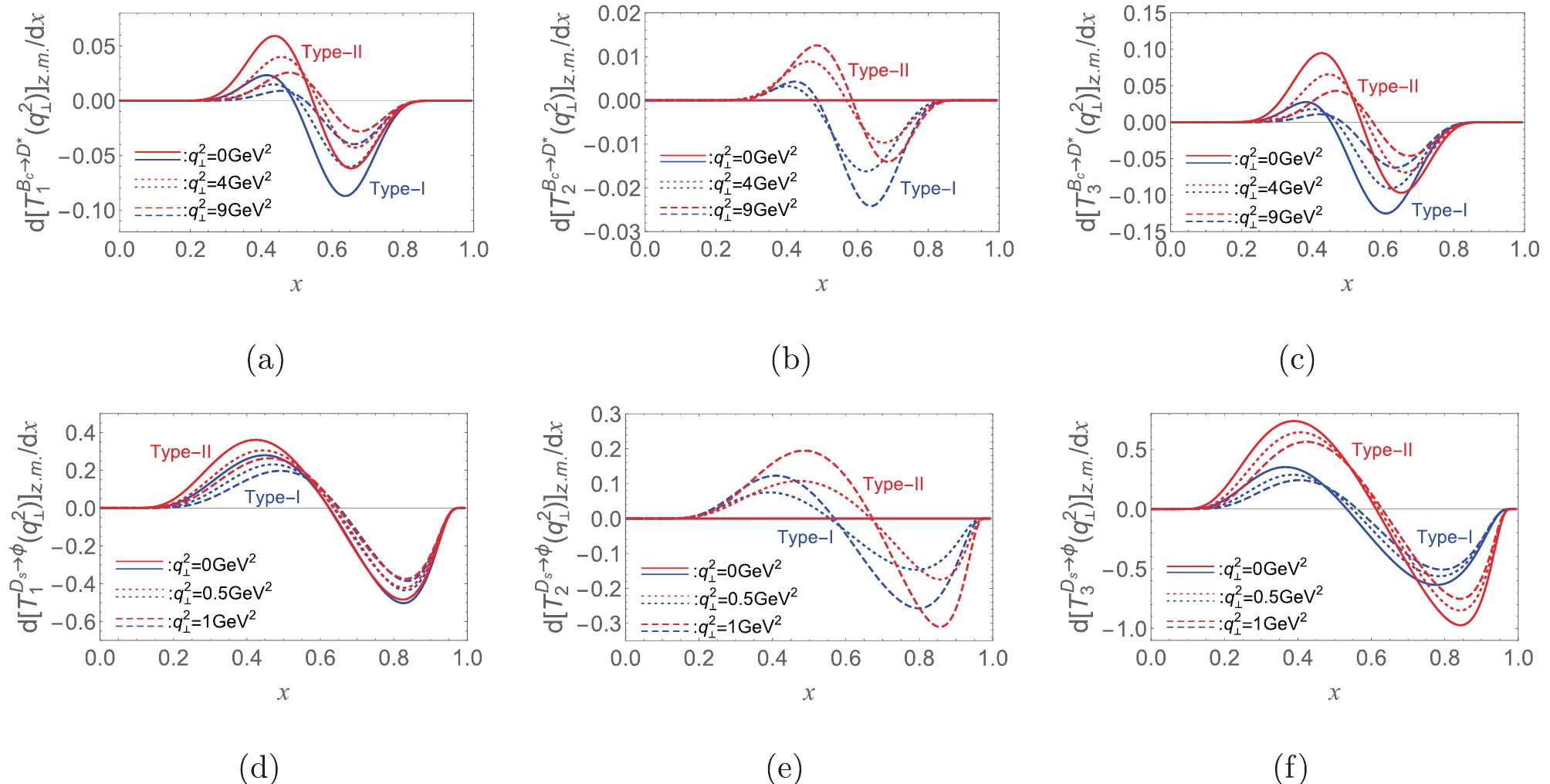
Figure 3. (color online) The dependences of
{{\rm{d}}} [T_{1,2,3}]_{\rm {z.m.}}/ {{\rm{d}}} x on x forB_{c}\to D^* transition at{\bf q}_{\bot}^2=(0,4,9)\,{{\rm {GeV}}^2} and forD_{s}\to \phi transition at{\bf q}_{\bot}^2=(0,0.5,1)\,{{\rm {GeV}}^2} .● Comparing
[T_{1,2,3}]^{\rm {SLF}} with[T_{1,2,3}]^{\rm val.} , which are given by Eqs. (28)–(29) and Eqs. (63)–(65), respectively, it can be found that the SLF results forT_{1,2,3} are exactly the same as the valence contributions in form after taking theM\to M_0 replacement (Type-II), which can also be clearly seen from the numerical results forT_1 in Table 1. This is exactly what we expect due to the following facts: (i) the CLF QM has employed the LF vertex functions, which can only be extracted by mapping the CLF result to the SLF one; (ii) the zero-mode contributions are not taken into account in the SLF result, therefore the SLF result is in fact only corresponding to the valence contribution in the CLF QM. The findings in this and last items can be concluded as[T_{1,2,3}]^{\rm {SLF}} = [T_{1,2,3}]^{\rm {val.}}\dot{ = }[T_{1,2,3}]^{\rm {CLF}}\,.\quad {({\rm{type-II}})}

(77) This relation is also valid for the form factors of
P\to A andP\to (P,S) transitions, while, for the later, the notation “\dot{ = } ” should be replaced by “= ” becauseF_T andU_T are zero-mode independent.The analyses and findings mentioned above confirm again the main conclusion obtained in our previous studies [85, 86] and Ref. [84]. In addition to above-mentioned self-consistency problem of CLF QM caused by the contributions associated with B function, we note a new inconsistency problem, which is discussed in the following.
The tensor form factors
T_{1,2,3} have also been obtained by Cheng and Chua (CC) in Ref. [82] within the CLF QM, and their results are summarized in Appendix A (Eqs. (A1)–(A3)) for convenience of discussion. Comparing our results given by Eqs. (56)–(58) with CC's results, one can easily find that the results forT_1 are consistent with each other, whereas the ones forT_{2} andT_{3} are obviously different. In addition, forT_{2} andT_{3} , it is found that our and CC's numerical results are also inconsistent with each other in the traditional Type-I scheme. After carefully checking our and CC's calculations, we find that such new inconsistency problem is caused by the different approaches to deal with the trace termS^{\mu\nu\lambda} related to the fermion-loop in{\cal B}_{\rm {CLF}}^{P\to V}[\Gamma = \sigma^{\mu\nu}\gamma_5] , where{\cal B}_{\rm {CLF}} and S have been given by Eq. (32) and Eq. (33), respectively. Explicitly,{\cal B}_{\rm {CLF}}^{P\to V}[\Gamma = \sigma^{\mu\nu}\gamma_5] is written as{\cal B}_{\rm {CLF}}^{P\to V}[\Gamma = \sigma^{\mu\nu}\gamma_5] = N_c \int \frac{{{\rm{d}}}^4 k_1'}{(2\pi)^4} \frac{H_{P}H_{V}}{N_1'\,N_1''\,N_2}iS^{\mu\nu\lambda}\epsilon^*_\lambda \,.

(78) The trace term,
S^{\mu\nu\lambda} , can be related toS'^{\rho\sigma\lambda} by using the identity2\sigma_{\mu\nu}\gamma_5 = i\varepsilon_{\mu\nu\rho\sigma}\sigma^{\rho\sigma} , whereS'^{\rho\sigma\lambda} is the trace term in{\cal B}_{\rm {CLF}}^{P\to V}[\Gamma = \sigma^{\rho\sigma}] corresponding toT_1 . Explicitly, it is written asS^{\mu\nu}_{\lambda} = \frac{i}{2}\varepsilon^{\mu\nu\rho\sigma} S'_{\rho\sigma\lambda} \qquad\qquad\qquad\qquad\qquad\qquad\qquad\qquad\qquad\qquad\qquad\qquad\;\;\qquad

(79) \begin{split} = &i\varepsilon^{\mu\nu\rho\sigma}\bigg\{ \varepsilon_{\rho\sigma\lambda\alpha}\left[2(m'_1m_2+m''_1m_2-m'_1m''_1)k'^\alpha_1+m'_1m''_1P^{\alpha}+(m'_1m''_1-2m'_1m_2)q^{\alpha}\right]\\ &-\varepsilon_{\rho\sigma\alpha\beta}\frac{(4k'_{1}-3q-P)_\lambda}{D''_V}\left[(m'_1+m''_1)k'^{\alpha}_1P^\beta+(m''_1-m'_1+2m_2)k'^{\alpha}_1q^\beta+m'_1P^\alpha q^\beta\right]\\ &+\varepsilon_{\rho\sigma\lambda\alpha}\left[2(k'_1\cdot k_2-k''_1\cdot k_2-k'_1\cdot k''_1)k'^{\alpha}_1+k'_1\cdot k''_1P^\alpha+(k'_1\cdot k''_1-2k'_1\cdot k_2)q^\alpha\right]\\ &+(g^{\sigma}_{\lambda}\varepsilon_{\rho\alpha\beta\gamma}-g^{\rho}_{\lambda}\varepsilon_{\sigma\alpha\beta\gamma})P^{\alpha}q^{\beta}k'^{\gamma}_1+\varepsilon_{\sigma\rho\alpha\beta}(P^\alpha q^\beta k'_{1\lambda}+k'^\alpha_1P^\beta q_{\lambda}+q^\alpha k'^\beta_1P_{\lambda})\\ &+\varepsilon_{\rho\lambda\alpha\beta}\left[ k'_{1\sigma}P^\alpha q^\beta+q_\sigma P^\alpha k'^\beta_1 +(P+2q)_\sigma q^\alpha k'^\beta_1+2k'_{1\sigma} k'^\alpha_1 (P+q)^\beta \right]\\ &-\varepsilon_{\sigma\lambda\alpha\beta} \left[k'_{1\rho}P^\alpha q^\beta+q_\rho P^\alpha k'^\beta_1+(P+2q)_\rho q^\alpha k'^\beta_1+2k'_{1\rho}k'^\alpha_1(P+q)^\beta\right] \bigg\}\,. \end{split}

(80) For convenience of discussion, we take the last term,
[S^{\mu\nu}_{\lambda}]_{{\rm{last}}\;{ \rm{term}}} = -2i\varepsilon^{\mu\nu\rho\sigma}\varepsilon_{\sigma\lambda\alpha\beta}\,k'_{1\rho}k'^\alpha_1(P+q)^\beta , as example.In the CC's calculation [82], the obtained result for
\hat{S}'_{\rho\sigma\lambda} is used directly to calculate\hat{S}^{\mu\nu}_{\lambda} using\hat{S}^{\mu\nu}_{\lambda} = \frac{i}{2}\varepsilon^{\mu\nu\rho\sigma} \hat{S}'_{\rho\sigma\lambda} , which is formally similar to Eq. (79). This implies that, after integrating outk'^-_{1} , the replacement for\hat{k}'^{\rho}_1\hat{k}'^\alpha_1 is made directly by using Eq. (48) even though\rho and\alpha are dummy indices; then, in the CC's approach, using the identity\begin{split} \varepsilon^{\mu\nu\rho\sigma}\varepsilon_{\sigma\lambda\alpha\beta} = &\left[g_\lambda^\mu(g_\alpha^\nu g_\beta^\rho-g_\alpha^\rho g_\beta^\nu)+g_\lambda^\nu(g_\alpha^\rho g_\beta^\mu-g_\alpha^\mu g_\beta^\rho)\right.\\ &\left.+g_\lambda^\rho(g_\alpha^\mu g_\beta^\nu-g_\alpha^\nu g_\beta^\mu)\right]\,, \end{split}

(81) the following is obtained
\begin{split} \left[\hat{S}^{\mu\nu}_{\lambda}\right]_{{\rm{last}}\;{ \rm{term}}}^{\rm{CC}} = &2i g_\lambda^\nu g_\alpha^\mu g_\beta^\rho\left[g^\alpha_\rho A^{(2)}_1+P^\alpha P_\rho A^{(2)}_2+(P_\rho q^\alpha+q_\rho P^\alpha)A^{(2)}_3+q^\alpha q_\rho A^{(2)}_4\right](P+q)^\beta\,+\,...\\ = &2ig_\lambda^\nu\left\{P^\mu\left[A^{(2)}_1+(3M'^2-M''^2-q^2)A^{(2)}_2+(M'^2-M''^2+q^2)A^{(2)}_3\right]\right.\\ &\left.+q^\mu\left[A^{(2)}_1+\left(3M'^2-M''^2-q^2\right)A^{(2)}_3+\left(M'^2-M''^2+q^2\right)A^{(2)}_4\right] \right\}\,+\,...\,, \end{split}

(82) where only the terms proportional to
g_\lambda^\nu g_\alpha^\mu g_\beta^\rho are shown for convenience of comparison with our corresponding result given in the following.In our calculation, we employ the standard procedure of the CLF calculation instead of directly using the obtained result for
\hat{S}'_{\rho\sigma\lambda} . First, we write[S^{\mu\nu}_{\lambda}]_{{\rm{last}}\;{ \rm{term}}} as\begin{split} \left[S^{\mu\nu}_{\lambda}\right]_{{\rm{last}}\;{ \rm{term}}}& = -2i g_\lambda^\nu k'^\mu_{1} k'_1\cdot(P+q)+...\\ & = -2i g_\lambda^\nu k'^\mu_{1} \left(M'^2+m'^2_1+m'^2_1-m^2_2- N_2 + N'_1 \right)+...\,, \end{split}

(83) where only the terms proportional to
g_\lambda^\nu g_\alpha^\mu g_\beta^\rho corresponding to the CC' result, Eq. (82), are shown, by using Eq. (81) andk'_1\cdot q = \frac{1}{2}\left(N'_1+m'^2_1- N''_1-m''^2_1-{ \bf q}_\bot^2\right)\,,

(84) k'_1\cdot P = \frac{1}{2}\left(2M'^2+ N'_1+m'^2_1+ N''_1+m''^2_1-2 N_2-2m^2_2+{ \bf q}_\bot^2\right)\,.

(85) Then, after integrating out
k'^-_{1} , we further make replacements for\hat{k}_1'^\mu and\hat{k}_1'^\mu\hat{N}_2 (note that\mu is the free index) using Eqs. (47) and (49). Finally, we arrive at\begin{split} \left[\hat{S}^{\mu\nu}_{\lambda}\right]_{{\rm{last}}\;{ \rm{term}}}^{\rm{ours}} = &2ig_\lambda^\nu\Bigg\{P^\mu\left(M'^2+m'^2_1-m_2^2{+}\hat N'_1\right)A^{(1)}_1\\ &+q^\mu\left\Bigg[\left(M'^2+m'^2_1-m_2^2{+}\hat N'_1-Z_2\right)A^{(1)}_2\right.\\&\left.-\frac{M'^2-M''^2}{q^2}A^{(2)}_1\right\Bigg] \Bigg\}+...\,. \end{split}

(86) Comparing CC's calculation with ours, it can be found that different replacements are required due to the different strategies for dealing with the S term, which further results in the different theoretical results for
\hat{S} , as well as for[T_2]^{\rm {CLF}} and[T_3]^{\rm {CLF}} . To clearly show the divergence between CC's results and ours, we takeB_c\to D^* andD_s\to \phi transitions as examples, and plot the difference defined by\Delta^{\cal F}_{\rm {CLF}}(x,{ \bf q}_\bot^2)\equiv \frac{{{\rm{d}}} [{\cal F}]^{\rm {CLF}}_{\rm ours}}{{{\rm{d}}} x}-\frac{{{\rm{d}}} [{\cal F}]^{\rm {CLF}}_{\rm CC}}{{{\rm{d}}} x}\,, \;\; {\cal F} = T_2\;{\rm{ and }}\; T_3

(87) in Fig. 4. Fig. 4 shows that our and CC's numerical results for
[T_{2,3}]^{\rm {CLF}} are inconsistent with each other within the traditional Type-I scheme, because[T_{2,3}]^{\rm {CLF}}_{\rm ours}\! -\! [T_{2,3}]^{\rm {CLF}}_{\rm CC} \!= \int_0^1 {{\rm{d}}} x\,\Delta_{\rm {CLF}}^{T_{2,3}}(x)\neq 0 ; however, interestingly the consistency can be achieved numerically within the Type-II scheme, because\int_0^1 {{\rm{d}}} x\,\Delta_{\rm {CLF}}^{T_{2,3}}(x) = 0 . The case ofP\to A transition is similar to the one ofP\to V transition.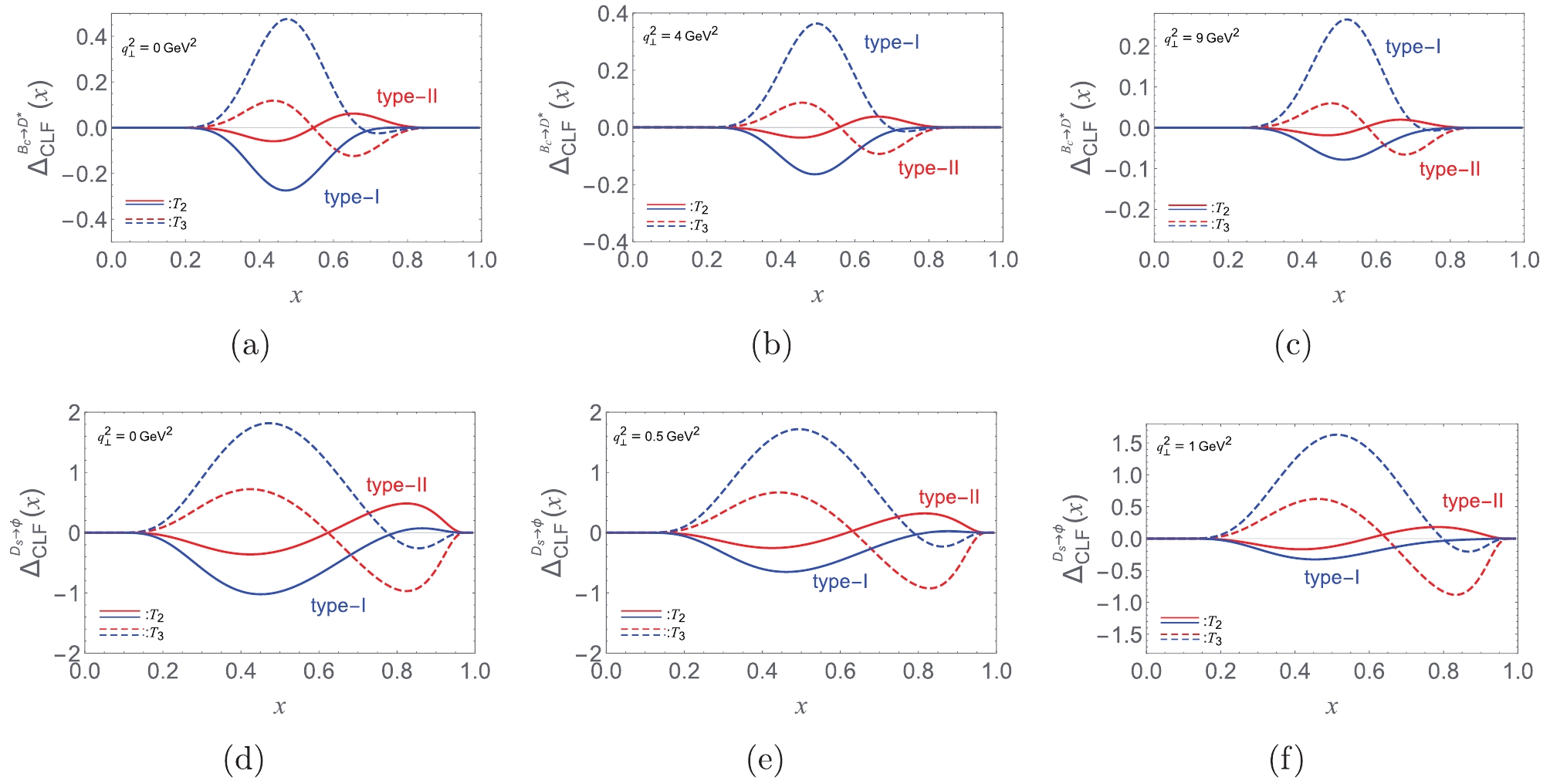
Figure 4. (color online)
\Delta^{T_{2,3}}_{\rm CLF}(x) forB_{c}\to D^* transition at{\bf q}_{\bot}^2=(0,4,9)\,{{\rm {GeV}}^2} and forD_{s}\to \phi transition at{\bf q}_{\bot}^2=(0,0.5,1)\,{{\rm {GeV}}^2} .From above analyses and discussions, it can be concluded that the Type-II scheme provides a feasible solution to the covariance and self-consistency problems of the CLF QM. Therefore, we update the CLF predictions for the tensor form factors of some
b\to c,\,s\,,q andc\to s,\,q (q = u,d ) inducedP\to P,\,S,\,V , and A transitions by employing the self-consistent Type-II scheme. The CLF results for the tensor form factors are obtained in theq^+ = 0 frame, which implies that the form factors are known only for space-like momentum transfer,q^2 = -{\bf q}_\bot^2\leqslant 0 , and the results in the time-like region need an additionalq^2 extrapolation. To achieve this purpose, the three parameters form [88]{\cal F}(q^2) = \dfrac{{\cal F}(0)}{1-a(q^2/M_{B,D}^2)+b(q^2/M_{B,D}^2)^2}\,,

(88) is usually employed by the LFQMs. In Eq. (88),
M_{B,D} is the mass of the relevant B and D mesons, andM_{B_{q,s,c}} andM_{D_{q,s}} (q = u\,,d ) is used forb\to (q,s,c) andc\to (q,s) transitions, respectively; a and b are parameters obtained by fitting to the results computed directly by LFMQs. However, for the case ofb\to light-quark transition with a heavy spectator quark, we find that the fitted results for b are very large, and some CLF results cannot be well reproduced using Eq. (88). Therefore, instead of Eq. (88), we employ an improved form [80]{\cal F}(q^2) = \dfrac{{\cal F}(0)}{\left( 1-q^2/M_{B,D}^2 \right)\left[1-a\left(q^2/M_{B,D}^2\right)+b\left(q^2/M_{B,D}^2\right)^2\right]}\,,

(89) which is suitable for most of form factors considered in this study. However, for
T_3^{(1)} of some transitions, the coefficient b is rather sensitive to the range ofq^2 . To overcome this difficulty, we fitT_3^{(1)} to the form [82]{\cal F}(q^2) = {\cal F}(0)\left[1+a\left(q^2/M_{B,D}^2\right)+b\left(q^2/M_{B,D}^2\right)^2\right]\,.

(90) Using the values of input parameters collected in Appendix B, we then present our numerical predictions for the tensor form factors in Tables 2–6; and the
q^2 -dependences are shown in Figs. 5–9. From these results, it can be found that the CLF results obtained in the space-like region are well reproduced by Eqs. (89) and (90), and are further extrapolated to the time-like space. Further, our results forP\to V and A transitions respect the relation thatT_1(0) = T_2(0) . These numerical results can be applied further in the relevant phenomenological studies of meson decays.{\cal{F}}(0) 

a b {\cal{F}}(0) 

a b F_T^{D\to \pi} 

0.84^{+0.16}_{-0.13} 

-0.03^{+0.26}_{-0.18} 

0.07^{+0.06}_{-0.09} 

F_T^{D_{s}\to K} 

0.93^{+0.20}_{-0.15} 

-0.01^{+0.29}_{-0.20} 

0.10^{+0.07}_{-0.10} 

F_T^{D\to K} 

0.96^{+0.17}_{-0.15} 

-0.02^{+0.23}_{-0.23} 

0.10^{+0.08}_{-0.10} 

F_T^{D_{s}\to \eta_{s}} 

1.05^{+0.21}_{-0.17} 

0.01^{+0.26}_{-0.20} 

0.14^{+0.09}_{-0.11} 

F_T^{B\to \pi} 

0.32^{+0.04}_{-0.04} 

0.42^{+0.14}_{-0.10} 

0.03^{+0.05}_{-0.06} 

F_T^{B_{s}\to K} 

0.30^{+0.06}_{-0.06} 

0.66^{+0.10}_{-0.08} 

0.17^{+0.05}_{-0.06} 

F_T^{B_{c}\to D} 

0.24^{+0.12}_{-0.10} 

1.38^{+0.10}_{-0.11} 

1.23^{+0.43}_{-0.42} 

F_T^{B\to K} 

0.39^{+0.06}_{-0.05} 

0.43^{+0.14}_{-0.10} 

0.02^{+0.05}_{-0.06} 

F_T^{B_{s}\to \eta_{s}} 

0.36^{+0.08}_{-0.07} 

0.66^{+0.07}_{-0.05} 

0.16^{+0.06}_{-0.07} 

F_T^{B_{c}\to D_{s}} 

0.36^{+0.14}_{-0.12} 

1.20^{+0.08}_{-0.09} 

0.87^{+0.29}_{-0.30} 

F_T^{B\to D} 

0.78^{+0.12}_{-0.12} 

0.49^{+0.10}_{-0.10} 

-0.02^{+0.01}_{-0.01} 

F_T^{B_{s}\to D_{s}} 

0.81^{+0.11}_{-0.14} 

0.57^{+0.03}_{-0.02} 

0.08^{+0.06}_{-0.06} 

F_T^{B_{c}\to \eta_{c}} 

0.90^{+0.17}_{-0.22} 

1.09^{+0.15}_{-0.20} 

0.57^{+0.23}_{-0.23} 

Table 2. Numerical results of tensor form factors for
c\to q\,,s (q = u\,,d ) inducedD_{q,s}\to P andb\to q\,,s\,,c inducedB_{q,s,c}\to P transitions. Theoretical errors are caused by uncertainties of input parameters (\beta andm_{q,s,c,b} ).\mathcal{F}(0) 

a b \mathcal{F}(0) 

a b U_T^{D\to S_{(q,\bar{q})}} 

0.77^{+0.13}_{-0.12} 

-0.17^{+0.26}_{-0.17} 

0.18^{+0.11}_{-0.18} 

U_T^{D_{s}\to S_{(q,\bar{s})}} 

0.94^{+0.17}_{-0.14} 

-0.16^{+0.26}_{-0.18} 

0.17^{+0.09}_{-0.14} 

U_T^{D\to S_{(s,\bar{q})}} 

0.74^{+0.13}_{-0.12} 

-0.17^{+0.25}_{-0.17} 

0.16^{+0.11}_{-0.16} 

U_T^{D_{s}\to S_{(s,\bar{s})}} 

0.93^{+0.16}_{-0.15} 

-0.18^{+0.26}_{-0.18} 

0.20^{+0.11}_{-0.16} 

U_T^{B\to S_{(q,\bar{q})}} 

0.35^{+0.05}_{-0.04} 

0.28^{+0.21}_{-0.17} 

0.02^{+0.04}_{-0.03} 

U_T^{B_{s}\to S_{(q,\bar{s})}} 

0.38^{+0.04}_{-0.05} 

0.47^{+0.08}_{-0.05} 

0.12^{+0.05}_{-0.07} 

U_T^{B_{c}\to S_{(q,\bar{c})}} 

0.40^{+0.13}_{-0.13} 

1.16^{+0.18}_{-0.17} 

0.88^{+0.38}_{-0.38} 

U_T^{B\to S_{(s,\bar{q})}} 

0.37^{+0.05}_{-0.05} 

0.25^{+0.19}_{-0.15} 

0.01^{+0.03}_{-0.03} 

U_T^{B_{s}\to S_{(s,\bar{s})}} 

0.43^{+0.06}_{-0.05} 

0.44^{+0.26}_{-0.21} 

0.11^{+0.05}_{-0.01} 

U_T^{B_{c}\to S_{(s,\bar{c})}} 

0.56^{+0.12}_{-0.14} 

0.98^{+0.10}_{-0.11} 

0.62^{+0.24}_{-0.24} 

U_T^{B\to S_{(c,\bar{q})}} 

0.51^{+0.09}_{-0.08} 

0.33^{+0.12}_{-0.07} 

-0.08^{+0.04}_{-0.05} 

U_T^{B_{s}\to S_{(c,\bar{s})}} 

0.71^{+0.12}_{-0.11} 

0.36^{+0.11}_{-0.11} 

0.03^{+0.01}_{-0.02} 

U_T^{B_{c}\to S_{(c,\bar{c})}} 

1.21^{+0.32}_{-0.25} 

0.83^{+0.35}_{-0.31} 

0.40^{+0.30}_{-0.16} 

Table 3. Same as Table 2 except for
D_{q,s}\to S andB_{q,s,c}\to S transitions.\mathcal{F}(0) 

a b \mathcal{F}(0) 

a b T_1^{D\to\rho} 

0.62_{-0.08}^{+0.08} 

0.05_{-0.18}^{+0.26} 

0.10_{-0.15}^{+0.08} 

T_1^{D_{s}\to K^*} 

0.56_{-0.09}^{+0.09} 

0.15^{+0.23}_{-0.16} 

0.11^{+0.09}_{-0.13} 

T_2^{D\to\rho} 

0.62_{-0.08}^{+0.08} 

-0.81^{+0.05}_{-0.05} 

0.59^{+0.03}_{-0.03} 

T_2^{D_{s}\to K^*} 

0.56_{-0.09}^{+0.09} 

-0.64^{+0.05}_{-0.15} 

0.47^{+0.03}_{-0.03} 

T_3^{D\to\rho} 

0.30^{+0.02}_{-0.02} 

-0.11^{+0.26}_{-0.16} 

0.15^{+0.11}_{-0.18} 

T_3^{D_{s}\to K^*} 

0.23_{-0.03}^{+0.02} 

-0.02^{+0.33}_{-0.12} 

0.15^{+0.04}_{-0.15} 

T_1^{D\to K^*} 

0.71_{-0.09}^{+0.08} 

0.07^{+0.20}_{-0.15} 

0.11^{+0.09}_{-0.12} 

T_1^{D_{s}\to \phi} 

0.69_{-0.10}^{+0.08} 

0.11^{+0.17}_{-0.13} 

0.13^{+0.08}_{-0.08} 

T_2^{D\to K^*} 

0.71_{-0.09}^{+0.08} 

-0.74^{+0.06}_{-0.06} 

0.55^{+0.16}_{-0.16} 

T_2^{D_{s}\to \phi} 

0.69_{-0.10}^{+0.08} 

-0.69^{+0.07}_{-0.07} 

0.48^{+0.02}_{-0.02} 

T_3^{D\to K^*} 

0.28_{-0.06}^{+0.03} 

-0.08^{+0.19}_{-0.18} 

0.15^{+0.11}_{-0.10} 

T_3^{D_{s}\to \phi} 

0.23_{-0.07}^{+0.03} 

-0.03^{+0.21}_{-0.20} 

0.17^{+0.10}_{-0.09} 

T_1^{B\to \rho} 

0.27_{-0.04}^{+0.05} 

0.55^{+0.14}_{-0.09} 

0.06^{+0.05}_{-0.06} 

T_1^{B_{s}\to K^{*}} 

0.19_{-0.05}^{+0.06} 

0.90^{+0.11}_{-0.09} 

0.33^{+0.07}_{-0.08} 

T_2^{B\to \rho} 

0.27_{-0.04}^{+0.05} 

-0.29^{+0.01}_{-0.01} 

0.19^{+0.02}_{-0.03} 

T_2^{B_{s}\to K^{*}} 

0.19_{-0.05}^{+0.06} 

0.10^{+0.06}_{-0.06} 

0.18^{+0.03}_{-0.04} 

T_3^{B\to \rho} 

0.18_{-0.03}^{+0.03} 

0.35^{+0.11}_{-0.07} 

0.09^{+0.03}_{-0.06} 

T_3^{B_{s}\to K^{*}} 

0.12_{-0.03}^{+0.03} 

0.69^{+0.08}_{-0.07} 

0.28^{+0.07}_{-0.07} 

T_1^{B_{c}\to D^{*}} 

0.11_{-0.04}^{+0.06} 

1.68^{+0.12}_{-0.12} 

1.85^{+0.57}_{-0.57} 

T_1^{B\to K^{*}} 

0.32_{-0.06}^{+0.06} 

0.56^{+0.12}_{-0.09} 

0.06^{+0.05}_{-0.06} 

T_2^{B_{c}\to D^{*}} 

0.11_{-0.04}^{+0.06} 

1.03^{+0.19}_{-0.23} 

0.94^{+0.43}_{-0.38} 

T_2^{B\to K^{*}} 

0.32_{-0.06}^{+0.06} 

-0.24^{+0.01}_{-0.01} 

0.16^{+0.02}_{-0.03} 

T_3^{B_{c}\to D^{*}} 

0.05_{-0.02}^{+0.03} 

1.46^{+0.27}_{-0.17} 

1.51^{+0.35}_{-0.52} 

T_3^{B\to K^{*}} 

0.20_{-0.03}^{+0.03} 

0.40^{+0.10}_{-0.07} 

0.08^{+0.04}_{-0.06} 

T_1^{B_{s}\to\phi} 

0.27_{-0.06}^{+0.07} 

0.82^{+0.09}_{-0.07} 

0.26^{+0.06}_{-0.07} 

T_1^{B_{c}\to D^{*}_{s}} 

0.20_{-0.07}^{+0.09} 

1.34^{+0.11}_{-0.11} 

1.06^{+0.34}_{-0.34} 

T_2^{B_{s}\to\phi} 

0.27_{-0.06}^{+0.07} 

0.05^{+0.04}_{-0.04} 

0.16^{+0.03}_{-0.03} 

T_2^{B_{c}\to D^{*}_{s}} 

0.20_{-0.07}^{+0.09} 

0.63^{+0.17}_{-0.20} 

0.49^{+0.22}_{-0.18} 

T_3^{B_{s}\to\phi} 

0.16_{-0.03}^{+0.04} 

0.64^{+0.07}_{-0.06} 

0.23^{+0.05}_{-0.06} 

T_3^{B_{c}\to D^{*}_{s}} 

0.10_{-0.03}^{+0.04} 

1.16^{+0.10}_{-0.11} 

0.87^{+0.30}_{-0.29} 

T_1^{B\to D^{*}} 

0.70_{-0.11}^{+0.10} 

0.55^{+0.04}_{-0.03} 

0.00^{+0.05}_{-0.04} 

T_1^{B_{s}\to D^{*}_{s}} 

0.70_{-0.12}^{+0.11} 

0.63^{+0.10}_{-0.10} 

0.10^{+0.06}_{-0.07} 

T_2^{B\to D^{*}} 

0.70_{-0.11}^{+0.10} 

-0.28^{+0.01}_{-0.02} 

0.19^{+0.03}_{-0.02} 

T_2^{B_{s}\to D^{*}_{s}} 

0.70_{-0.12}^{+0.11} 

-0.22^{+0.07}_{-0.07} 

0.24^{+0.02}_{-0.02} 

T_3^{B\to D^{*}} 

0.30_{-0.03}^{+0.01} 

0.42^{+0.08}_{-0.10} 

0.02^{+0.02}_{-0.02} 

T_3^{B_{s}\to D^{*}_{s}} 

0.30_{-0.02}^{+0.02} 

0.54^{+0.01}_{-0.01} 

0.06^{+0.01}_{-0.01} 

T_1^{B_{c}\to J/ \Psi} 

0.56_{-0.17}^{+0.16} 

1.30^{+0.17}_{-0.23} 

0.80^{+0.31}_{-0.31} 

T_2^{B_{c}\to J/ \Psi} 

0.56_{-0.17}^{+0.16} 

0.54^{+0.20}_{-0.29} 

0.34^{+0.16}_{-0.12} 

T_3^{B_{c}\to J/ \Psi} 

0.19_{-0.03}^{+0.03} 

1.17^{+0.03}_{-0.02} 

0.68^{+0.17}_{-0.21} 

Table 4. Same as Table 2 except for
D_{q,s}\to V andB_{q,s,c}\to V transitions.\mathcal{F}(0) 

a b \mathcal{F}(0) 

a b T_1^{D\to {^1\!A}_{(q,\bar{q})}} 

0.23^{+0.02}_{-0.03} 

0.02^{+0.23}_{-0.14} 

0.18^{+0.10}_{-0.15} 

T_1^{D_{s}\to {^1\!A}_{(q,\bar{s})}} 

0.19^{+0.02}_{-0.03} 

0.13^{+0.20}_{-0.20} 

0.18^{+0.08}_{-0.14} 

T_2^{D\to {^1\!A}_{(q,\bar{q})}} 

0.23^{+0.02}_{-0.03} 

-0.82^{+0.07}_{-0.13} 

0.72^{+0.09}_{-0.06} 

T_2^{D_{s}\to {^1\!A}_{(q,\bar{s})}} 

0.19^{+0.02}_{-0.03} 

-0.40^{+0.04}_{-0.04} 

0.35^{+0.14}_{-0.14} 

T_3^{D\to {^1\!A}_{(q,\bar{q})}} 

-0.02^{+0.12}_{-0.09} 

3.76^{+0.25}_{-0.25} 

5.25^{+0.47}_{-0.47} 

T_3^{D_{s}\to {^1\!A}_{(q,\bar{s})}} 

-0.13^{+0.12}_{-0.06} 

1.16^{+0.07}_{-0.07} 

1.01^{+0.23}_{-0.23} 

T_1^{D\to {^1\!A}_{(s,\bar{q})}} 

0.19^{+0.03}_{-0.04} 

0.04^{+0.21}_{-0.21} 

0.20^{+0.09}_{-0.09} 

T_1^{D_{s}\to {^1\!A}_{(s,\bar{s})}} 

0.16^{+0.03}_{-0.03} 

0.09^{+0.28}_{-0.22} 

0.20^{+0.09}_{-0.08} 

T_2^{D\to {^1\!A}_{(s,\bar{q})}} 

0.19^{+0.03}_{-0.04} 

-1.32^{+0.26}_{-0.40} 

1.69^{+0.59}_{-0.59} 

T_2^{D_{s}\to {^1\!A}_{(s,\bar{s})}} 

0.16^{+0.03}_{-0.03} 

-0.83^{+0.04}_{-0.20} 

0.79^{+0.18}_{-0.06} 

T_3^{D\to {^1\!A}_{(s,\bar{q})}} 

0.01^{+0.17}_{-0.11} 

-4.77^{+0.40}_{-0.40} 

-9.34^{+0.50}_{-0.49} 

T_3^{D_{s}\to {^1\!A}_{(s,\bar{s})}} 

-0.10^{+0.11}_{-0.11} 

1.10^{+0.38}_{-0.38} 

0.93^{+0.26}_{-0.26} 

T_1^{B\to {^1\!A}_{(q,\bar{q})}} 

0.12^{+0.03}_{-0.03} 

0.72^{+0.11}_{-0.08} 

0.17^{+0.05}_{-0.05} 

T_1^{B_{s}\to {^1\!A}_{(q,\bar{s})}} 

0.08^{+0.03}_{-0.03} 

1.07^{+0.05}_{-0.05} 

0.53^{+0.11}_{-0.10} 

T_2^{B\to {^1\!A}_{(q,\bar{q})}} 

0.12^{+0.03}_{-0.03} 

-0.15^{+0.06}_{-0.08} 

0.19^{+0.03}_{-0.03} 

T_2^{B_{s}\to {^1\!A}_{(q,\bar{s})}} 

0.08^{+0.03}_{-0.03} 

0.33^{+0.11}_{-0.13} 

0.20^{+0.07}_{-0.03} 

T_3^{B\to {^1\!A}_{(q,\bar{q})}} 

-0.01^{+0.02}_{-0.03} 

3.37^{+0.14}_{-0.14} 

3.09^{+0.24}_{-0.24} 

T_3^{B_{s}\to {^1\!A}_{(q,\bar{s})}} 

-0.07^{+0.03}_{-0.03} 

1.87^{+0.27}_{-0.22} 

1.30^{+0.23}_{-0.23} 

T_1^{B_{c}\to {^1\!A}_{(q,\bar{c})}} 

0.03^{+0.03}_{-0.01} 

1.78^{+0.16}_{-0.16} 

2.05^{+0.67}_{-0.67} 

T_1^{B\to {^1\!A}_{(s,\bar{q})}} 

0.13^{+0.03}_{-0.03} 

0.72^{+0.09}_{-0.06} 

0.18^{+0.05}_{-0.06} 

T_2^{B_{c}\to {^1\!A}_{(q,\bar{c})}} 

0.03^{+0.03}_{-0.01} 

1.55^{+0.24}_{-0.28} 

1.51^{+0.69}_{-0.69} 

T_2^{B\to {^1\!A}_{(s,\bar{q})}} 

0.13^{+0.03}_{-0.03} 

-0.27^{+0.13}_{-0.13} 

0.28^{+0.06}_{-0.05} 

T_3^{B_{c}\to {^1\!A}_{(q,\bar{c})}} 

-0.17^{+0.05}_{-0.03} 

2.41^{+0.13}_{-0.13} 

2.02^{+0.15}_{-0.16} 

T_3^{B\to {^1\!A}_{(s,\bar{q})}} 

-0.02^{+0.03}_{-0.04} 

2.88^{+0.51}_{-0.51} 

2.55^{+0.58}_{-0.58} 

T_1^{B_{s}\to {^1\!A}_{(s,\bar{s})}} 

0.09^{+0.03}_{-0.02} 

0.97^{+0.05}_{-0.03} 

0.42^{+0.07}_{-0.07} 

T_1^{B_{c}\to {^1\!A}_{(s,\bar{c})}} 

0.06^{+0.03}_{-0.03} 

1.41^{+0.15}_{-0.14} 

1.19^{+0.49}_{-0.40} 

T_2^{B_{s}\to {^1\!A}_{(s,\bar{s})}} 

0.09^{+0.03}_{-0.02} 

0.11^{+0.13}_{-0.16} 

0.22^{+0.02}_{-0.02} 

T_2^{B_{c}\to {^1\!A}_{(s,\bar{c})}} 

0.06^{+0.03}_{-0.03} 

1.11^{+0.24}_{-0.27} 

0.74^{+0.49}_{-0.38} 

T_3^{B_{s}\to {^1\!A}_{(s,\bar{s})}} 

-0.10^{+0.04}_{-0.04} 

1.93^{+0.24}_{-0.18} 

1.43^{+0.28}_{-0.21} 

T_3^{B_{c}\to {^1\!A}_{(s,\bar{c})}} 

-0.28^{+0.07}_{-0.10} 

2.22^{+0.39}_{-0.37} 

1.82^{+0.54}_{-0.47} 

T_1^{B\to {^1\!A}_{(c,\bar{q})}} 

0.15^{+0.02}_{-0.02} 

0.64^{+0.01}_{-0.01} 

0.11^{+0.04}_{-0.03} 

T_1^{B_{s}\to {^1\!A}_{(c,\bar{s})}} 

0.12^{+0.02}_{-0.01} 

0.73^{+0.17}_{-0.13} 

0.22^{+0.04}_{-0.05} 

T_2^{B\to {^1\!A}_{(c,\bar{q})}} 

0.15^{+0.02}_{-0.02} 

-1.89^{+0.44}_{-0.65} 

2.90^{+0.94}_{-0.94} 

T_2^{B_{s}\to {^1\!A}_{(c,\bar{s})}} 

0.12^{+0.02}_{-0.01} 

-1.57^{+0.05}_{-0.05} 

2.31^{+0.06}_{-0.06} 

T_3^{B\to {^1\!A}_{(c,\bar{q})}} 

-0.07^{+0.10}_{-0.06} 

3.56^{+0.92}_{-0.92} 

4.69^{+0.89}_{-0.89} 

T_3^{B_{s}\to {^1\!A}_{(c,\bar{s})}} 

-0.20^{+0.10}_{-0.06} 

2.42^{+0.20}_{-0.20} 

2.82^{+0.39}_{-0.39} 

T_1^{B_{c}\to {^1\!A}_{(c,\bar{c})}} 

0.08^{+0.02}_{-0.02} 

1.34^{+0.05}_{-0.04} 

0.88^{+0.21}_{-0.21} 

T_2^{B_{c}\to {^1\!A}_{(c,\bar{c})}} 

0.08^{+0.02}_{-0.02} 

0.23^{+0.20}_{-0.21} 

0.47^{+0.04}_{-0.04} 

T_3^{B_{c}\to {^1\!A}_{(c,\bar{c})}} 

-0.48^{+0.12}_{-0.11} 

2.45^{+0.60}_{-0.60} 

2.90^{+0.52}_{-0.52} 

Table 5. Same as Table 2 except for
D_{q,s} \to ^1\!A andB_{q,s,c} \to ^1\!A transitions.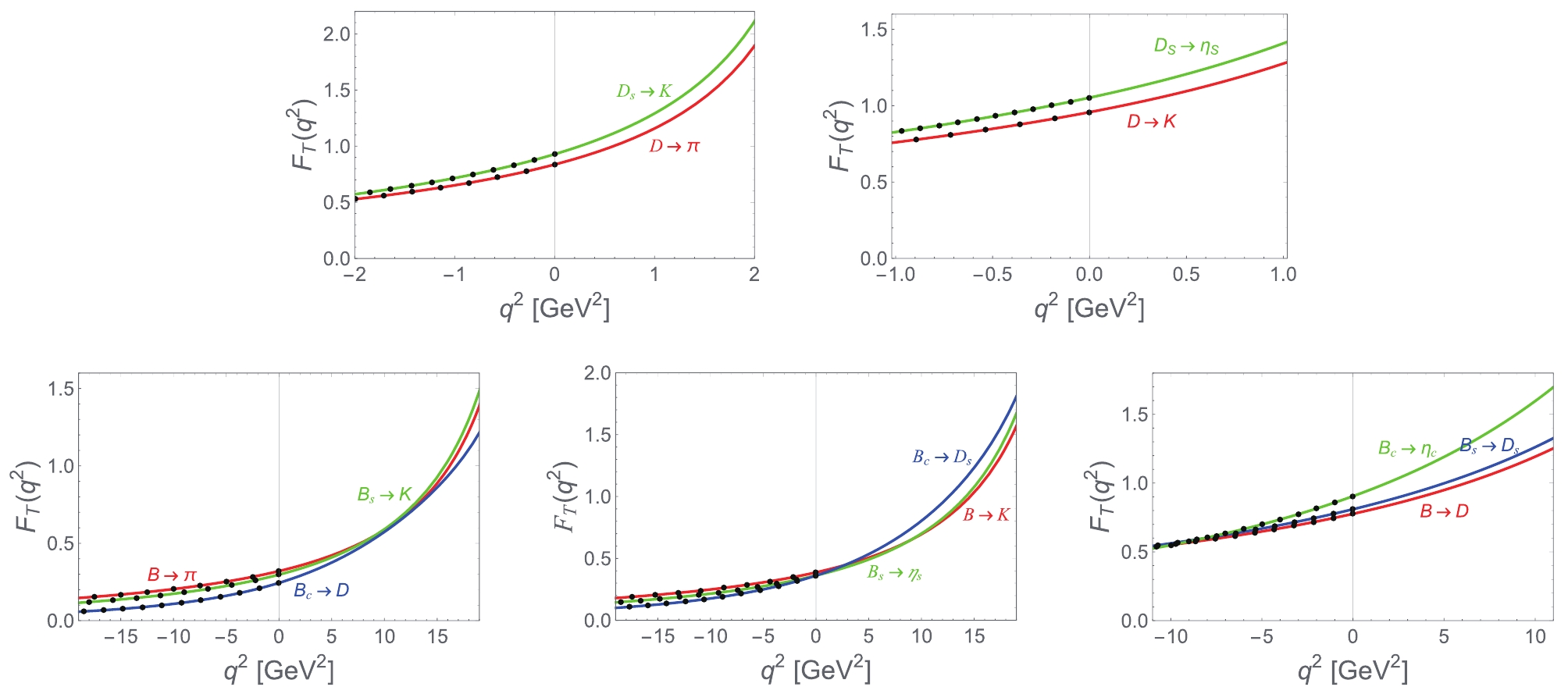
Figure 5. (color online)
q^2 dependences of tensor form factors forc\to q\,,s (q = u\,,d ) inducedD_{q,s}\to P andb\to q\,,s\,,c inducedB_{q,s,c}\to P transitions. Dots in the space-like region are the results obtained directly via the CLF QM, and the lines depict fitting results.{\cal{F}}(0) 

a b {\cal{F}}(0) 

a b T_1^{D\to {^3\!A}_{(q,\bar{q})}} 

0.49^{+0.05}_{-0.04} 

-0.09^{+0.29}_{-0.21} 

0.17^{+0.14}_{-0.18} 

T_1^{D_{s}\to {^3\!A}_{(q,\bar{s})}} 

0.49^{+0.05}_{-0.05} 

-0.04^{+0.32}_{-0.22} 

0.19^{+0.12}_{-0.17} 

T_2^{D\to {^3\!A}_{(q,\bar{q})}} 

0.49^{+0.05}_{-0.04} 

-2.06^{+0.66}_{-0.66} 

3.24^{+0.41}_{-0.41} 

T_2^{D_{s}\to {^3\!A}_{(q,\bar{s})}} 

0.49^{+0.05}_{-0.05} 

-1.93^{+0.43}_{-0.66} 

3.06^{+0.53}_{-0.53} 

T_3^{D\to {^3\!A}_{(q,\bar{q})}} 

0.50^{+0.12}_{-0.10} 

-0.21^{+0.29}_{-0.21} 

0.20^{+0.19}_{-0.18} 

T_3^{D_{s}\to {^3\!A}_{(q,\bar{s})}} 

0.54^{+0.14}_{-0.11} 

-0.14^{+0.34}_{-0.24} 

0.22^{+0.19}_{-0.19} 

T_1^{D\to {^3\!A}_{(s,\bar{q})}} 

0.43^{+0.05}_{-0.07} 

-0.09^{+0.14}_{-0.13} 

0.18^{+0.11}_{-0.11} 

T_1^{D_{s}\to {^3\!A}_{(s,\bar{s})}} 

0.47^{+0.04}_{-0.06} 

-0.07^{+0.11}_{-0.10} 

0.22^{+0.08}_{-0.10} 

T_2^{D\to {^3\!A}_{(s,\bar{q})}} 

0.43^{+0.05}_{-0.07} 

-3.05^{+0.72}_{-0.72} 

7.09^{+0.51}_{-0.51} 

T_2^{D_{s}\to {^3\!A}_{(s,\bar{s})}} 

0.47^{+0.04}_{-0.06} 

-3.10^{+0.79}_{-0.79} 

7.20^{+0.14}_{-0.14} 

T_3^{D\to {^3\!A}_{(s,\bar{q})}} 

0.51^{+0.14}_{-0.13} 

-0.26^{+0.39}_{-0.27} 

0.28^{+0.22}_{-0.29} 

T_3^{D_{s}\to {^3\!A}_{(s,\bar{s})}} 

0.66^{+0.16}_{-0.13} 

-0.14^{+0.28}_{-0.22} 

0.19^{+0.20}_{-0.11} 

T_1^{B\to {^3\!A}_{(q,\bar{q})}} 

0.29^{+0.03}_{-0.03} 

0.35^{+0.21}_{-0.20} 

0.03^{+0.03}_{-0.02} 

T_1^{B_{s}\to {^3\!A}_{(q,\bar{s})}} 

0.26^{+0.04}_{-0.06} 

0.65^{+0.06}_{-0.04} 

0.21^{+0.07}_{-0.09} 

T_2^{B\to {^3\!A}_{(q,\bar{q})}} 

0.29^{+0.03}_{-0.03} 

-0.71^{+0.01}_{-0.01} 

0.46^{+0.05}_{-0.02} 

T_2^{B_{s}\to {^3\!A}_{(q,\bar{s})}} 

0.26^{+0.04}_{-0.06} 

-0.38^{+0.14}_{-0.16} 

0.37^{+0.07}_{-0.05} 

T_3^{B\to {^3\!A}_{(q,\bar{q})}} 

0.25^{+0.04}_{-0.03} 

0.12^{+0.23}_{-0.18} 

0.12^{+0.03}_{-0.02} 

T_3^{B_{s}\to {^3\!A}_{(q,\bar{s})}} 

0.25^{+0.04}_{-0.05} 

0.49^{+0.01}_{-0.01} 

0.23^{+0.06}_{-0.07} 

T_1^{B_{c}\to {^3\!A}_{(q,\bar{c})}} 

0.18^{+0.09}_{-0.07} 

1.43^{+0.19}_{-0.21} 

1.28^{+0.51}_{-0.51} 

T_1^{B\to {^3\!A}_{(s,\bar{q})}} 

0.29^{+0.04}_{-0.03} 

0.34^{+0.23}_{-0.19} 

0.04^{+0.02}_{-0.02} 

T_2^{B_{c}\to {^3\!A}_{(q,\bar{c})}} 

0.18^{+0.09}_{-0.07} 

0.46^{+0.39}_{-0.44} 

0.71^{+0.13}_{-0.13} 

T_2^{B\to {^3\!A}_{(s,\bar{q})}} 

0.29^{+0.04}_{-0.03} 

-0.85^{+0.02}_{-0.04} 

0.61^{+0.10}_{-0.07} 

T_3^{B_{c}\to {^3\!A}_{(q,\bar{c})}} 

0.23^{+0.09}_{-0.08} 

1.49^{+0.18}_{-0.23} 

1.34^{+0.51}_{-0.51} 

T_3^{B\to {^3\!A}_{(s,\bar{q})}} 

0.26^{+0.05}_{-0.04} 

0.03^{+0.21}_{-0.16} 

0.16^{+0.03}_{-0.02} 

T_1^{B_{s}\to {^3\!A}_{(s,\bar{s})}} 

0.31^{+0.04}_{-0.04} 

0.57^{+0.07}_{-0.04} 

0.16^{+0.06}_{-0.07} 

T_1^{B_{c}\to {^3\!A}_{(s,\bar{c})}} 

0.30^{+0.09}_{-0.09} 

1.09^{+0.18}_{-0.17} 

0.75^{+0.40}_{-0.32} 

T_2^{B_{s}\to {^3\!A}_{(s,\bar{s})}} 

0.31^{+0.04}_{-0.04} 

-0.61^{+0.16}_{-0.21} 

0.53^{+0.16}_{-0.10} 

T_2^{B_{c}\to {^3\!A}_{(s,\bar{c})}} 

0.30^{+0.09}_{-0.09} 

-0.12^{+0.41}_{-0.45} 

0.62^{+0.14}_{-0.14} 

T_3^{B_{s}\to {^3\!A}_{(s,\bar{s})}} 

0.31^{+0.03}_{-0.04} 

0.38^{+0.20}_{-0.16} 

0.20^{+0.02}_{-0.02} 

T_3^{B_{c}\to {^3\!A}_{(s,\bar{c})}} 

0.43^{+0.11}_{-0.12} 

1.16^{+0.17}_{-0.19} 

0.78^{+0.39}_{-0.32} 

T_1^{B\to {^3\!A}_{(c,\bar{q})}} 

0.34^{+0.05}_{-0.06} 

0.39^{+0.03}_{-0.03} 

-0.03^{+0.04}_{-0.04} 

T_1^{B_{s}\to {^3\!A}_{(c,\bar{s})}} 

0.43^{+0.04}_{-0.07} 

0.45^{+0.02}_{-0.02} 

0.05^{+0.07}_{-0.07} 

T_2^{B\to {^3\!A}_{(c,\bar{q})}} 

0.34^{+0.05}_{-0.06} 

-2.73^{+0.55}_{-0.55} 

4.69^{+0.29}_{-0.29} 

T_2^{B_{s}\to {^3\!A}_{(c,\bar{s})}} 

0.43^{+0.04}_{-0.07} 

-2.73^{+0.55}_{-0.55} 

4.72^{+0.34}_{-0.34} 

T_3^{B\to {^3\!A}_{(c,\bar{q})}} 

0.44^{+0.12}_{-0.04} 

0.02^{+0.21}_{-0.21} 

0.14^{+0.22}_{-0.22} 

T_3^{B_{s}\to {^3\!A}_{(c,\bar{s})}} 

0.67^{+0.17}_{-0.14} 

0.28^{+0.17}_{-0.15} 

0.09^{+0.04}_{-0.02} 

T_1^{B_{c}\to {^3\!A}_{(c,\bar{c})}} 

0.50^{+0.01}_{-0.04} 

1.05^{+0.38}_{-0.38} 

0.56^{+0.30}_{-0.26} 

T_2^{B_{c}\to {^3\!A}_{(c,\bar{c})}} 

0.50^{+0.01}_{-0.04} 

-2.29^{+0.14}_{-0.23} 

4.79^{+0.16}_{-0.23} 

T_3^{B_{c}\to {^3\!A}_{(c,\bar{c})}} 

1.06^{+0.37}_{-0.25} 

1.06^{+0.44}_{-0.41} 

0.57^{+0.28}_{-0.27} 

Table 6. Same as Table 2 except for
D_{q,s} \to ^3\!A andB_{q,s,c} \to ^3\!A transitions.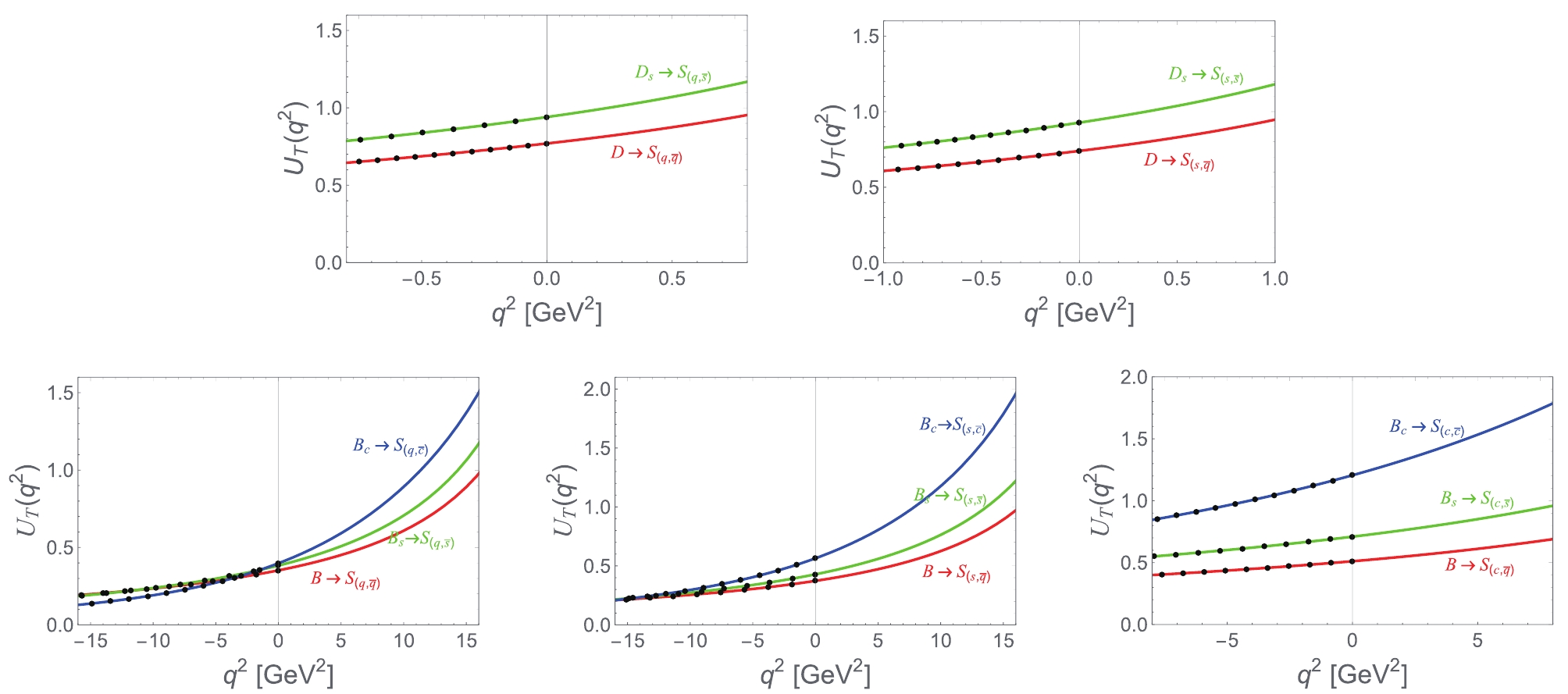
Figure 6. (color online) Same as Fig. 5 except for
D_{q,s}\to S andB_{q,s,c}\to S transitions.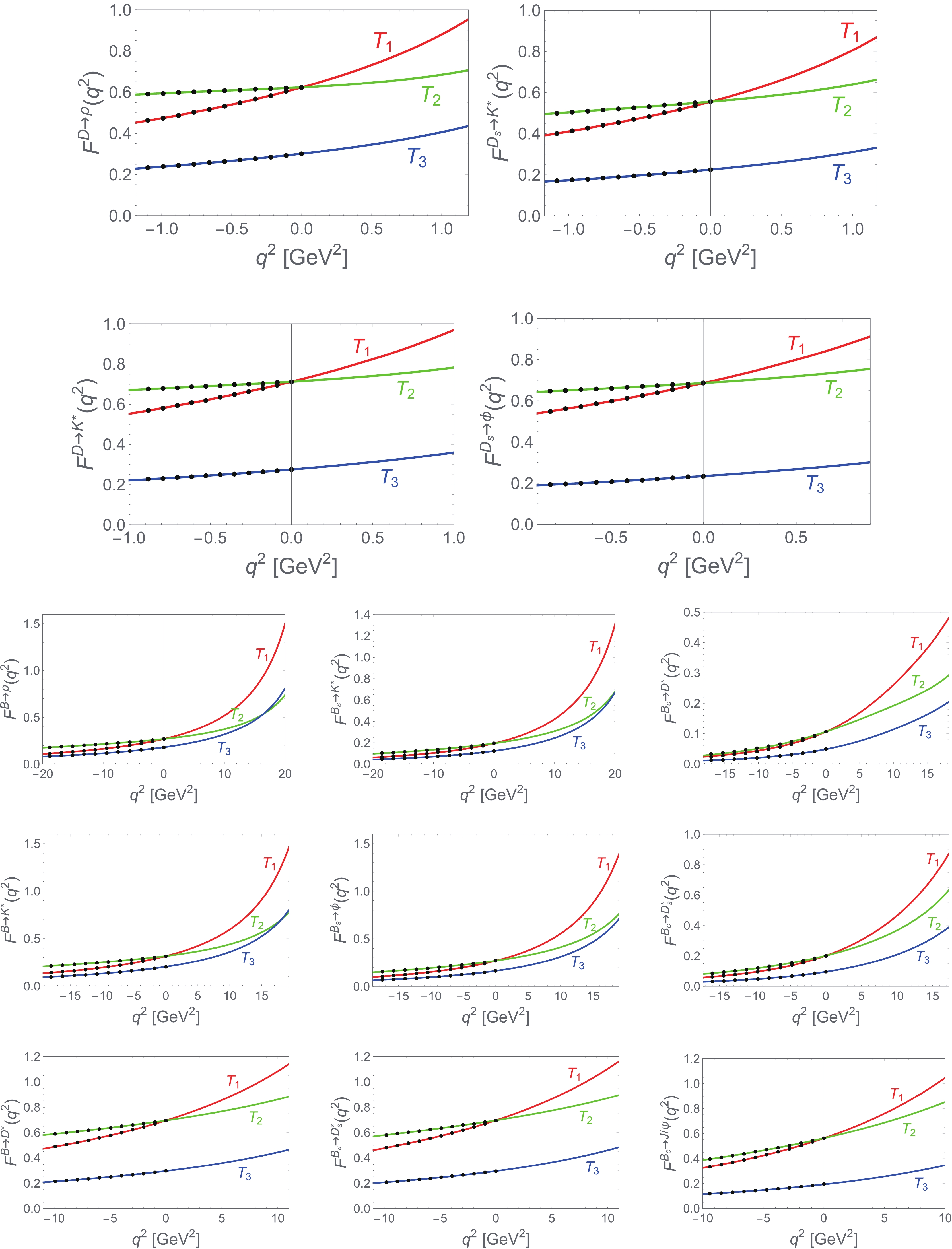
Figure 7. (color online) Same as Fig. 5 except for
D_{q,s}\to V andB_{q,s,c}\to V transitions.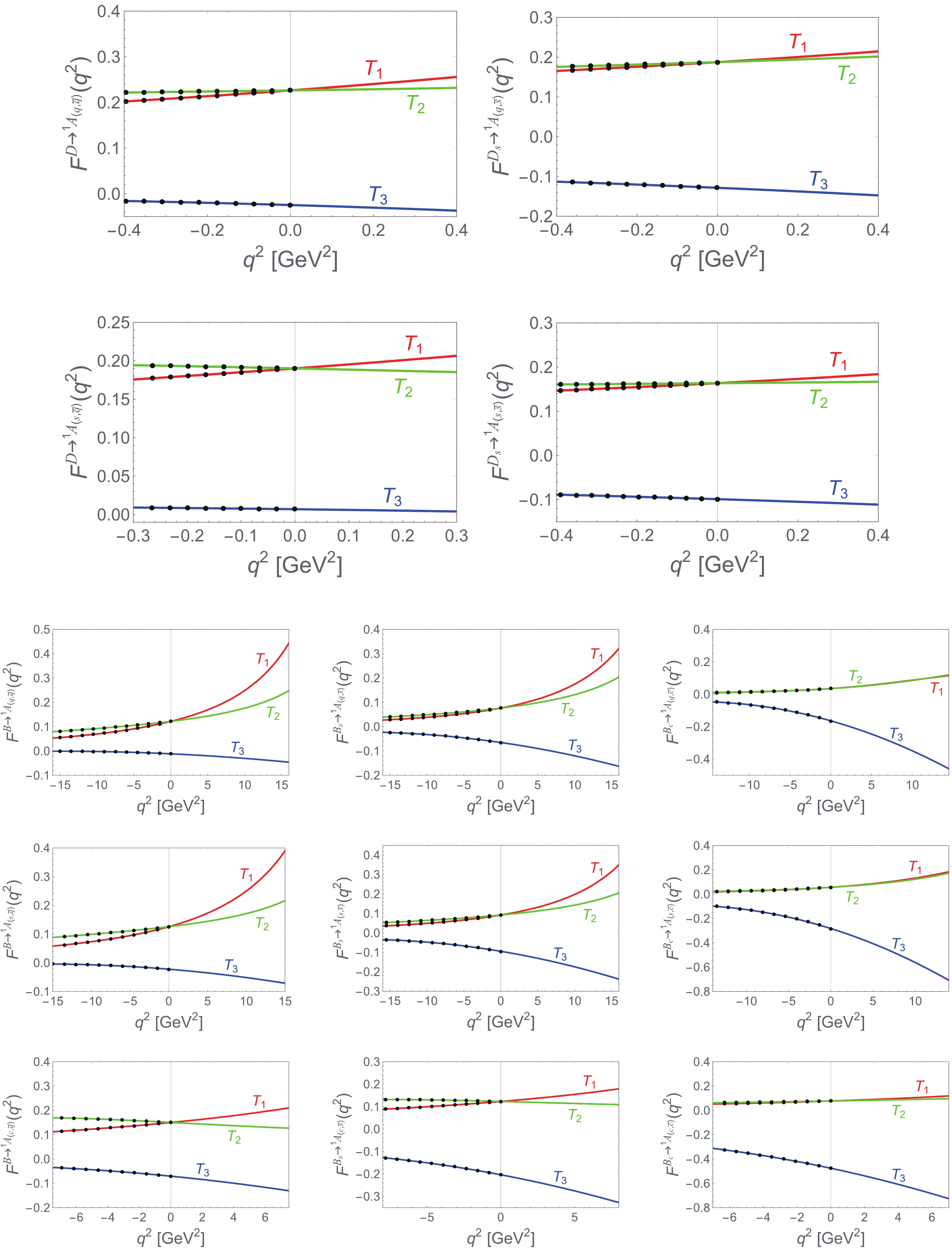
Figure 8. (color online) Same as Fig. 5 except for
D_{q,s}\to {^1\!A} andB_{q,s,c}\to {^1\!A} transitions.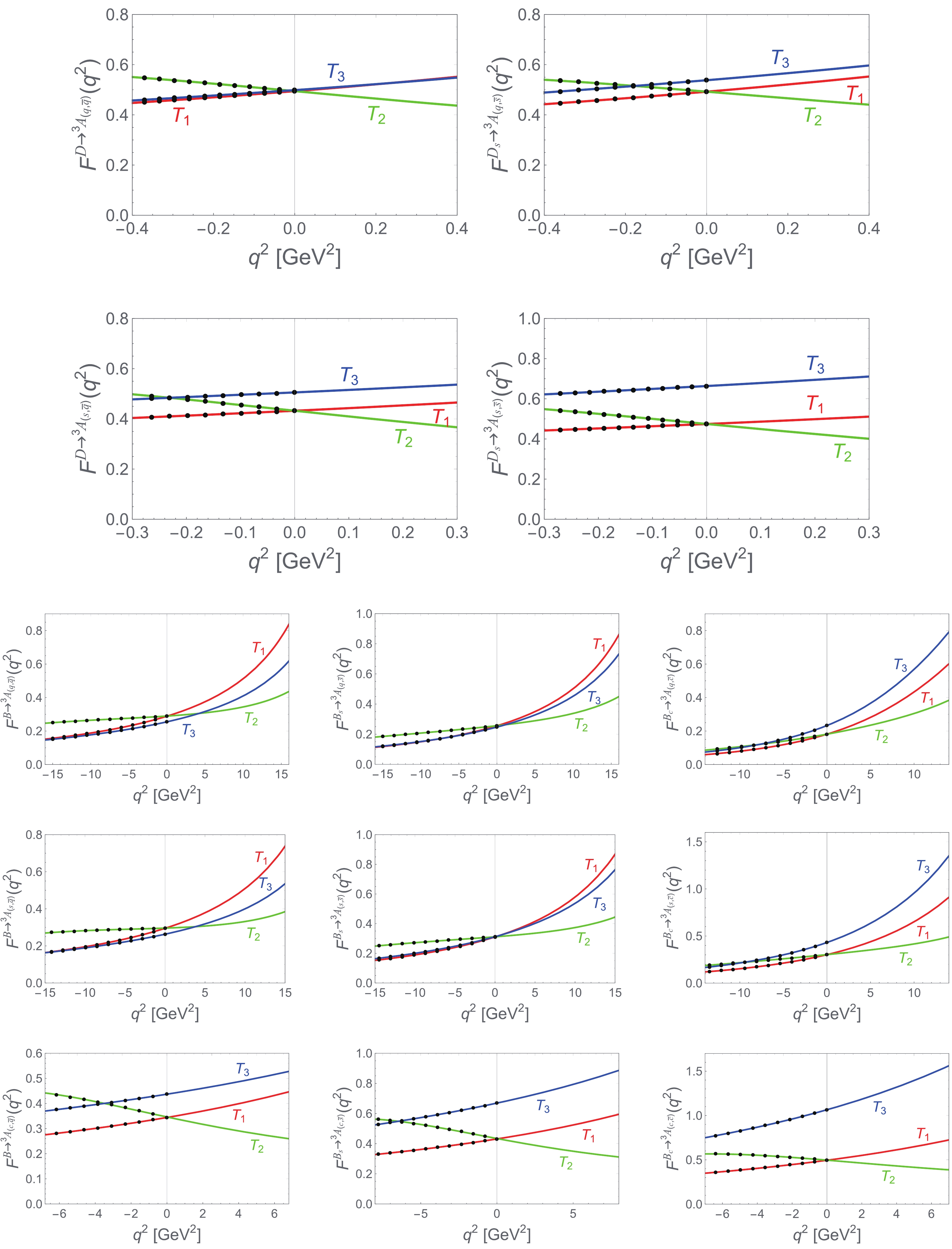
Figure 9. (color online) Same as Fig. 5 except for
D_{q,s}\to {^3\!A} andB_{q,s,c}\to {^3\!A} transitions. -
Motivated by the problems of LFQMs, we investigated the tensor matrix elements and relevant form factors of
P\to P,\,S,\,V , and A transitions within the SLF and the CLF approaches. The self-consistency and Lorentz covariance of the CLF predictions for the tensor matrix elements and form factors are analyzed in detail, and moreover, the zero-mode effects and the relation between valence contribution and SLF result are studied. As pointed out in our previous studies, the covariance is in fact violated in the CLF QM with the traditional correspondence scheme (Type-I) between the manifest covariant BS and the LF approaches; moreover, forP\to V and A transitions, the tensor form factors extracted via\lambda = 0 and\pm polarization states of V and A mesons are inconsistent with each other,[{\cal F}]^{\rm {full}}_{\lambda = 0}\neq [{\cal F}]^{\rm {full}}_{\lambda = +}\neq [{\cal F}]^{\rm {full}}_{\lambda = -} (Type-I), which implies that CLF QM has a problem of self-consistency. Two such problems have the same origin (the non-vanishing\omega -dependent spurious contributions associated with B functions), and can be resolved simultaneously by employing the improved Type-II correspondence scheme, which requires an additional replacementM\to M_0 relative to the traditional Type-I scheme. Within the Type-II scheme, the zero-mode corrections are only responsible for neutralizing spurious\omega -dependent contributions associated with C functions, but do not contribute numerically to the form factors; and the valence contributions in the CLF QM are exactly the same as the SLF results. The findings mentioned above confirm again the main conclusions obtained in Ref. [84] and our previous studies [85–87].Besides, we find a “novel” self-consistence problem of the CLF approach with the traditional Type-I scheme. Different strategies for dealing with the trace term, S, in the CLF matrix element would result in different formulas for the tensor form factors
T_{2(3)} ofP\to V and A transitions, and the numerical results are also inconsistent with each other within the Type-I scheme; however, interestingly, this new inconsistency problem can also be overcome numerically by employing the Type-II scheme. Finally, using the CLF approach with the covariant and self-consistent Type-II scheme, the theoretical predictions for the tensor form factors ofc\to q\,,s (q = u\,,d ) inducedD_{q,s}\to P,\,S,\,V,\,A andb\to q\,,s\,,c inducedB_{q,s,c}\to P,\,S,\,V,\,A transitions are updated. -
The tensor form factors of
P\to V transition in the CLF QM have been obtained in previous studies [81, 82], and can also been written as Eq. (53) with the integrands,\tag{A1} \begin{split} \widetilde{T}_1^{\rm{ CLF}} = &2A_1^{(1)}\left[M'^2-M''^2-2m'^2_1-2\hat N'_1+q^2+2\left(m'_1m_2+m''_1m_2-m'_1m''_1\right)\right]-8A_1^{(2)}+(m'_1+m''_1)^2+\hat N'_1+\hat N''_1-q^2+4\left(M'^2-M''^2\right)\left(A_2^{(2)}-A_3^{(2)}\right)\\ &+4q^2\left(-A_1^{(1)}+A_2^{(1)}+A_3^{(2)}-A_4^{(2)}\right)-\frac{4}{D''_{V,{\rm {con}}}}\left(m'_1+m''_1\right)A_1^{(2)}\,, \end{split}

\tag{A2} \begin{split} \widetilde{T}_2^{\rm{ CLF}} = &\widetilde{T}_1^{\rm{ CLF}}+\frac{q^2}{M'^2-M''^2}\bigg\{2A_2^{(1)}\left[M'^2-M''^2-2m'^2_1-2\hat N'_1+q^2+2\left(m'_1m_2+m''_1m_2-m'_1m''_1\right)\right]\\ &-8A_1^{(2)}-2M'^2+2m'^2_1+\left(m'_1+m''_1\right)^2+2(m_2-2m'_1)m_2+3\hat N'_1+\hat N''_1-q^2+2Z_2\\ &+4\left(q^2-2M'^2-2M''^2\right)\left(A_2^{(2)}-A_3^{(2)}\right)-4\left(M'^2-M''^2\right)\left(-A_1^{(1)}+A_2^{(1)}+A_3^{(2)}-A_4^{(2)}\right)-\frac{4}{D''_{V,{\rm {con}}}}\left(m''_1-m'_1+2m_2\right)A_1^{(2)} \bigg\}\,, \end{split}

\tag{A3} \begin{split} \widetilde{T}_3^{\rm{ CLF}} = &-2A_2^{(1)}\left[M'^2-M''^2-2m'^2_1-2\hat N'_1+q^2+2\left(m'_1m_2+m''_1m_2-m'_1m''_1\right)\right]+8A_1^{(2)}\\ &+2M'^2-2m'^2_1-(m'_1+m''_1)^2-2(m_2-2m'_1)m_2-3\hat N'_1-\hat N''_1+q^2-2Z_2-4\left(q^2-M'^2-3M''^2\right)\left(A_2^{(2)}-A_3^{(2)}\right)\\ &+\frac{4}{D''_{V,{\rm {con}}}}\bigg\{\left(m''_1-m'_1+2m_2\right)\left[A_1^{(2)}+\left(M'^2-M''^2\right)\left(A_2^{(2)}+A_3^{(2)}-A_1^{(1)}\right)\right]\\ &+\left(m'_1+m''_1\right)\left(M'^2-M''^2\right)\left(A_2^{(1)}-A_3^{(2)}-A_4^{(2)}\right)+m'_1\left(M'^2-M''^2\right)\left(A_1^{(1)}+A_2^{(1)}-1\right) \bigg\}\,. \end{split}

The results for
P\to A transition can be obtained via. the relations given by Eqs. (59) and (60). -
The masses of valence quark and Gaussian parameters
\beta are essential inputs for computing the form factors. For the former, we take [87]\tag{B1} \begin{split} m_q& = 230\pm40\,{\rm {MeV}}\,,\quad m_s = 430\pm60\,{\rm {MeV}}\,,\\ m_c& = 1600\pm300\,{\rm {MeV}}\,,\quad m_b = 4900\pm400\,{\rm {MeV}}\,, \end{split}

which can properly cover the fitting results and suggested values given in the previous studies, for instance, the result obtained via variational analyses of meson mass spectra for the Hamiltonian with a smeared-out hyperfine interaction [89], the values obtained by the variational principle for the linear and harmonic oscillator (HO) confining potentials, respectively [90], the fitting results obtained via decay constants and mean square radii of mesons [29], some commonly used values in the LFQMs [60, 61], etc. For the latter, its value for a given meson can be obtained by fitting to the data of decay constant. Using the data of decay constant,
f_{P,V} , collected in Ref. [85] and the default values of quark masses given by Eq. (94), we obtained the values of\beta collected in Table B1, where it has been assumed that\beta_{q_1\bar{q}_2} is universal forP(V) andS(A) mesons due to the lack of data forf_{S,A} . In addition, the self-consistent Type-II scheme is employed for computing decay constants.\beta_{q\bar{q}} 

\beta_{s\bar{q}} 

\beta_{s\bar{s}} 

\beta_{c\bar{q}} 

\beta_{c\bar{s}} 

P (S) 348\pm1 

365\pm2 

384\pm3 

473\pm12 

543\pm10 

V (A) 312\pm6 

313\pm10 

348\pm6 

429\pm13 

530\pm19 

\beta_{c\bar{c}} 

\beta_{b\bar{q}} 

\beta_{b\bar{s}} 

\beta_{b\bar{c}} 

\beta_{b\bar{b}} 

P (S) 753\pm14 

552\pm10 

606\pm12 

939\pm11 

1394\pm12 

V (A) 703\pm7 

516\pm15 

568\pm10 

876\pm20 

1390\pm12 

Table B1. Gaussian parameters
\beta (in units of MeV).
Tensor form factors of P→ P, S, V and A transitions within standard and covariant light-front approaches
- Received Date: 2020-03-12
- Available Online: 2020-08-01
Abstract: We investigate the tensor form factors of






 Abstract
Abstract HTML
HTML Reference
Reference Related
Related PDF
PDF










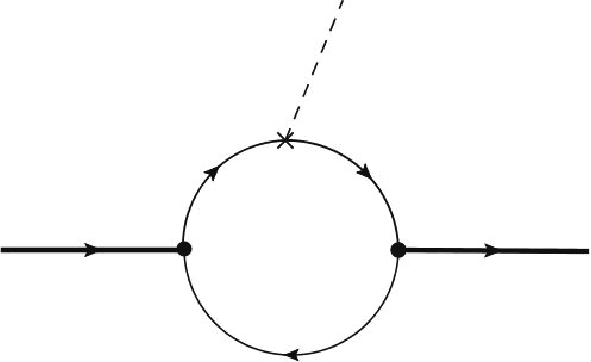













 DownLoad:
DownLoad: